Wireless Local Area Network: Design and Implementation for HCP Corporation
VerifiedAdded on 2023/06/11
|38
|7186
|353
AI Summary
This paper examines the networking issues faced by HCP Corporation and proposes the implementation of a wireless local area network to provide network coverage for the whole building. It discusses the current network limitations, additional capabilities required, and proposed network components, including WLAN topologies and security measures.
Contribute Materials
Your contribution can guide someone’s learning journey. Share your
documents today.

Wireless Local Area Network
Name
Institution
Date
Name
Institution
Date
Secure Best Marks with AI Grader
Need help grading? Try our AI Grader for instant feedback on your assignments.
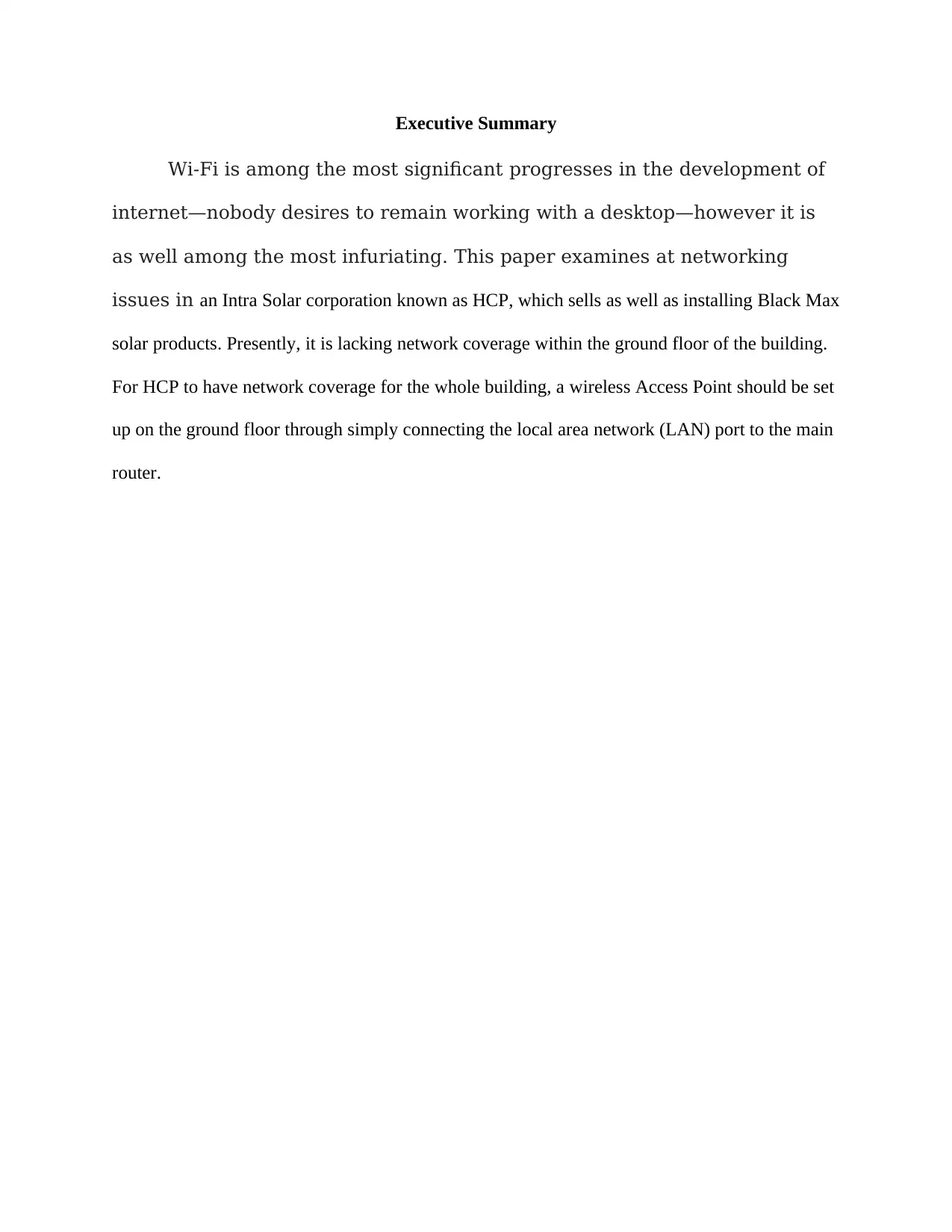
Executive Summary
Wi-Fi is among the most significant progresses in the development of
internet—nobody desires to remain working with a desktop—however it is
as well among the most infuriating. This paper examines at networking
issues in an Intra Solar corporation known as HCP, which sells as well as installing Black Max
solar products. Presently, it is lacking network coverage within the ground floor of the building.
For HCP to have network coverage for the whole building, a wireless Access Point should be set
up on the ground floor through simply connecting the local area network (LAN) port to the main
router.
Wi-Fi is among the most significant progresses in the development of
internet—nobody desires to remain working with a desktop—however it is
as well among the most infuriating. This paper examines at networking
issues in an Intra Solar corporation known as HCP, which sells as well as installing Black Max
solar products. Presently, it is lacking network coverage within the ground floor of the building.
For HCP to have network coverage for the whole building, a wireless Access Point should be set
up on the ground floor through simply connecting the local area network (LAN) port to the main
router.
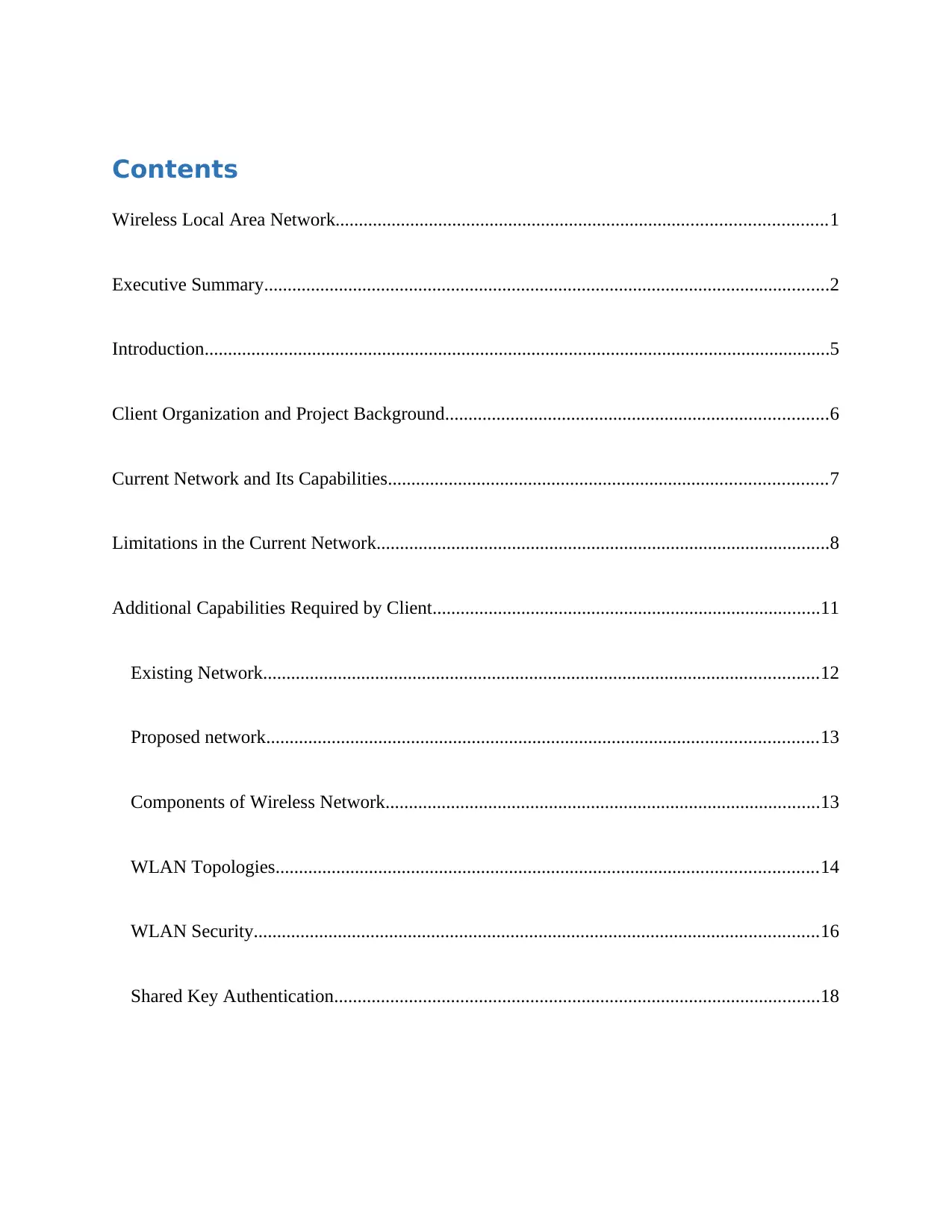
Contents
Wireless Local Area Network.........................................................................................................1
Executive Summary.........................................................................................................................2
Introduction......................................................................................................................................5
Client Organization and Project Background..................................................................................6
Current Network and Its Capabilities..............................................................................................7
Limitations in the Current Network.................................................................................................8
Additional Capabilities Required by Client...................................................................................11
Existing Network.......................................................................................................................12
Proposed network......................................................................................................................13
Components of Wireless Network.............................................................................................13
WLAN Topologies....................................................................................................................14
WLAN Security.........................................................................................................................16
Shared Key Authentication........................................................................................................18
Wireless Local Area Network.........................................................................................................1
Executive Summary.........................................................................................................................2
Introduction......................................................................................................................................5
Client Organization and Project Background..................................................................................6
Current Network and Its Capabilities..............................................................................................7
Limitations in the Current Network.................................................................................................8
Additional Capabilities Required by Client...................................................................................11
Existing Network.......................................................................................................................12
Proposed network......................................................................................................................13
Components of Wireless Network.............................................................................................13
WLAN Topologies....................................................................................................................14
WLAN Security.........................................................................................................................16
Shared Key Authentication........................................................................................................18
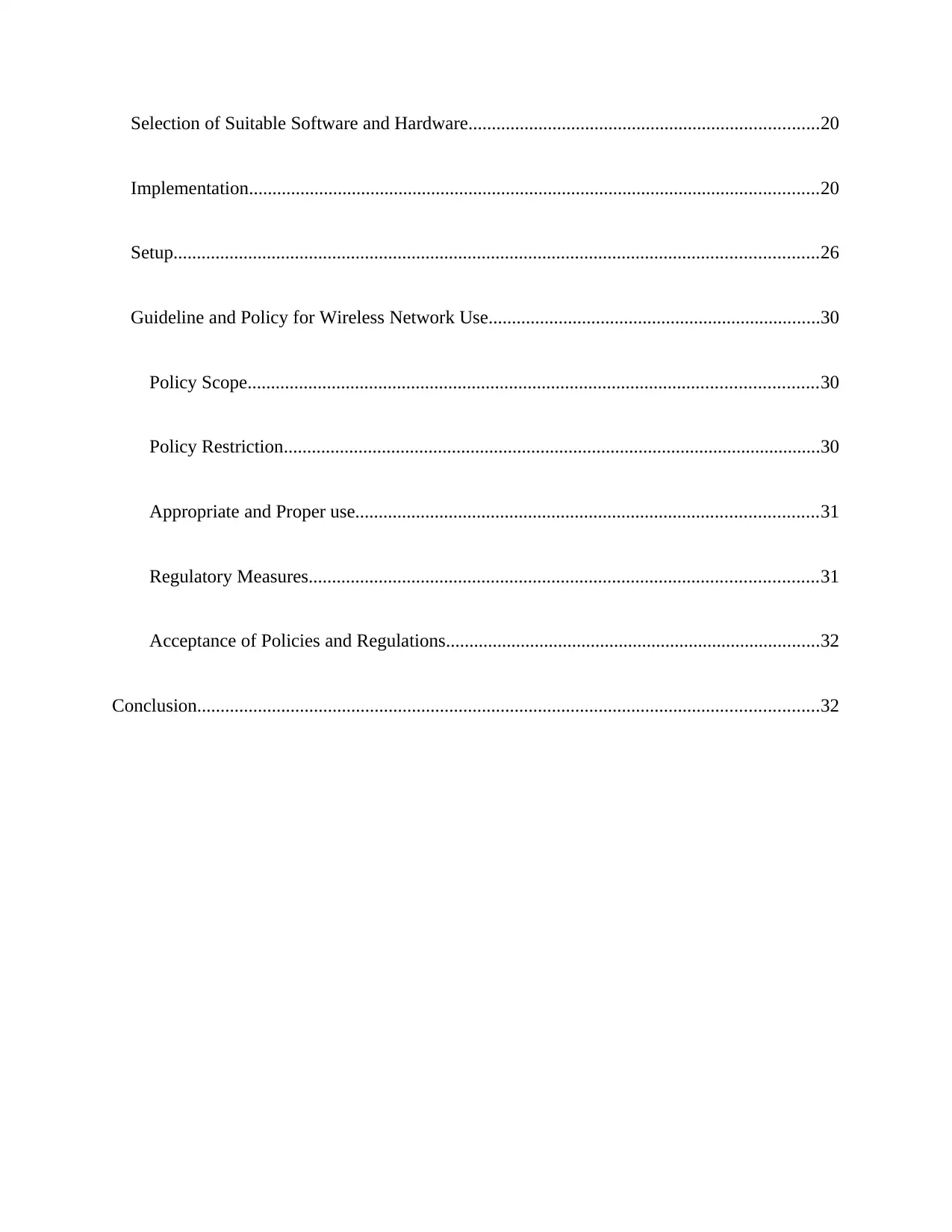
Selection of Suitable Software and Hardware...........................................................................20
Implementation..........................................................................................................................20
Setup..........................................................................................................................................26
Guideline and Policy for Wireless Network Use.......................................................................30
Policy Scope..........................................................................................................................30
Policy Restriction...................................................................................................................30
Appropriate and Proper use...................................................................................................31
Regulatory Measures.............................................................................................................31
Acceptance of Policies and Regulations................................................................................32
Conclusion.....................................................................................................................................32
Implementation..........................................................................................................................20
Setup..........................................................................................................................................26
Guideline and Policy for Wireless Network Use.......................................................................30
Policy Scope..........................................................................................................................30
Policy Restriction...................................................................................................................30
Appropriate and Proper use...................................................................................................31
Regulatory Measures.............................................................................................................31
Acceptance of Policies and Regulations................................................................................32
Conclusion.....................................................................................................................................32
Secure Best Marks with AI Grader
Need help grading? Try our AI Grader for instant feedback on your assignments.
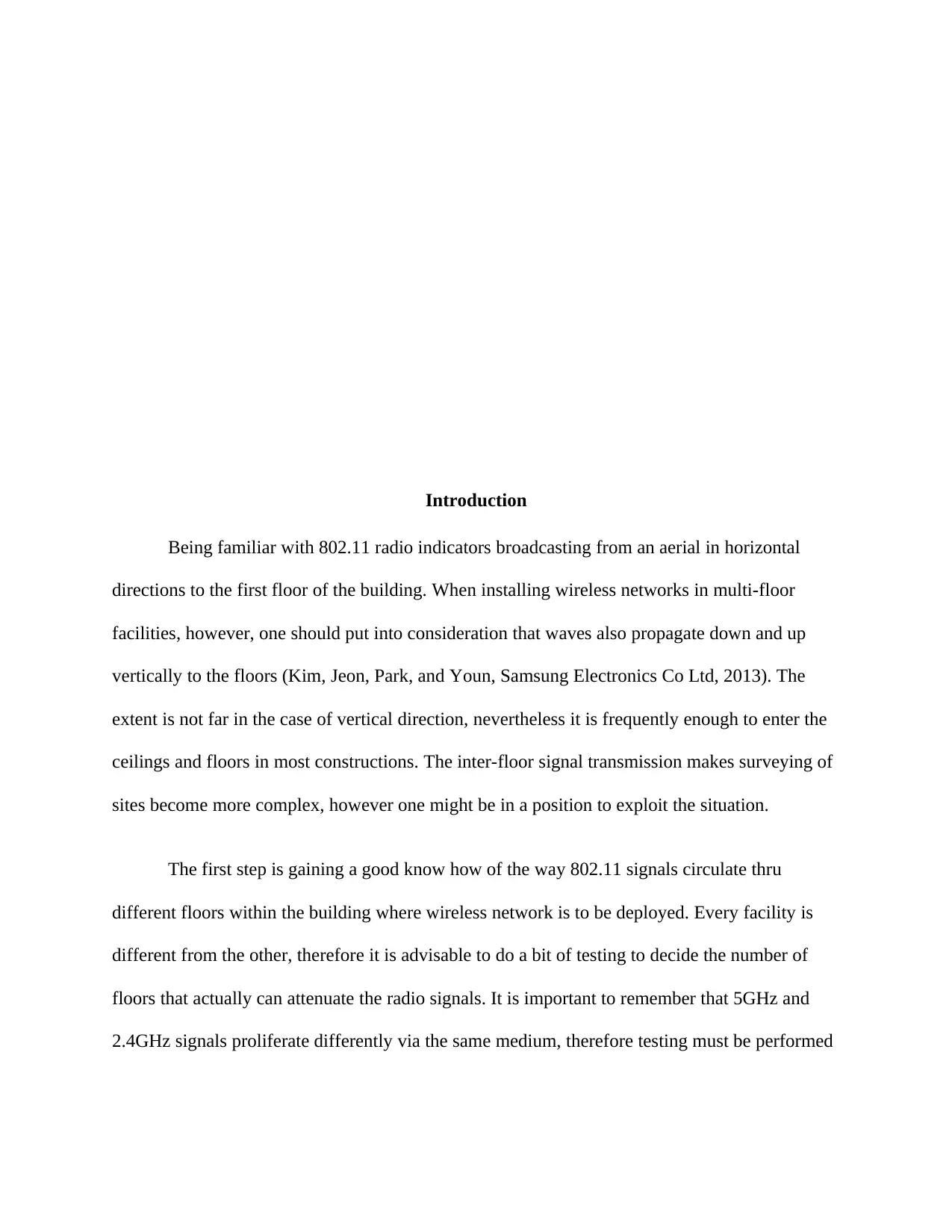
Introduction
Being familiar with 802.11 radio indicators broadcasting from an aerial in horizontal
directions to the first floor of the building. When installing wireless networks in multi-floor
facilities, however, one should put into consideration that waves also propagate down and up
vertically to the floors (Kim, Jeon, Park, and Youn, Samsung Electronics Co Ltd, 2013). The
extent is not far in the case of vertical direction, nevertheless it is frequently enough to enter the
ceilings and floors in most constructions. The inter-floor signal transmission makes surveying of
sites become more complex, however one might be in a position to exploit the situation.
The first step is gaining a good know how of the way 802.11 signals circulate thru
different floors within the building where wireless network is to be deployed. Every facility is
different from the other, therefore it is advisable to do a bit of testing to decide the number of
floors that actually can attenuate the radio signals. It is important to remember that 5GHz and
2.4GHz signals proliferate differently via the same medium, therefore testing must be performed
Being familiar with 802.11 radio indicators broadcasting from an aerial in horizontal
directions to the first floor of the building. When installing wireless networks in multi-floor
facilities, however, one should put into consideration that waves also propagate down and up
vertically to the floors (Kim, Jeon, Park, and Youn, Samsung Electronics Co Ltd, 2013). The
extent is not far in the case of vertical direction, nevertheless it is frequently enough to enter the
ceilings and floors in most constructions. The inter-floor signal transmission makes surveying of
sites become more complex, however one might be in a position to exploit the situation.
The first step is gaining a good know how of the way 802.11 signals circulate thru
different floors within the building where wireless network is to be deployed. Every facility is
different from the other, therefore it is advisable to do a bit of testing to decide the number of
floors that actually can attenuate the radio signals. It is important to remember that 5GHz and
2.4GHz signals proliferate differently via the same medium, therefore testing must be performed
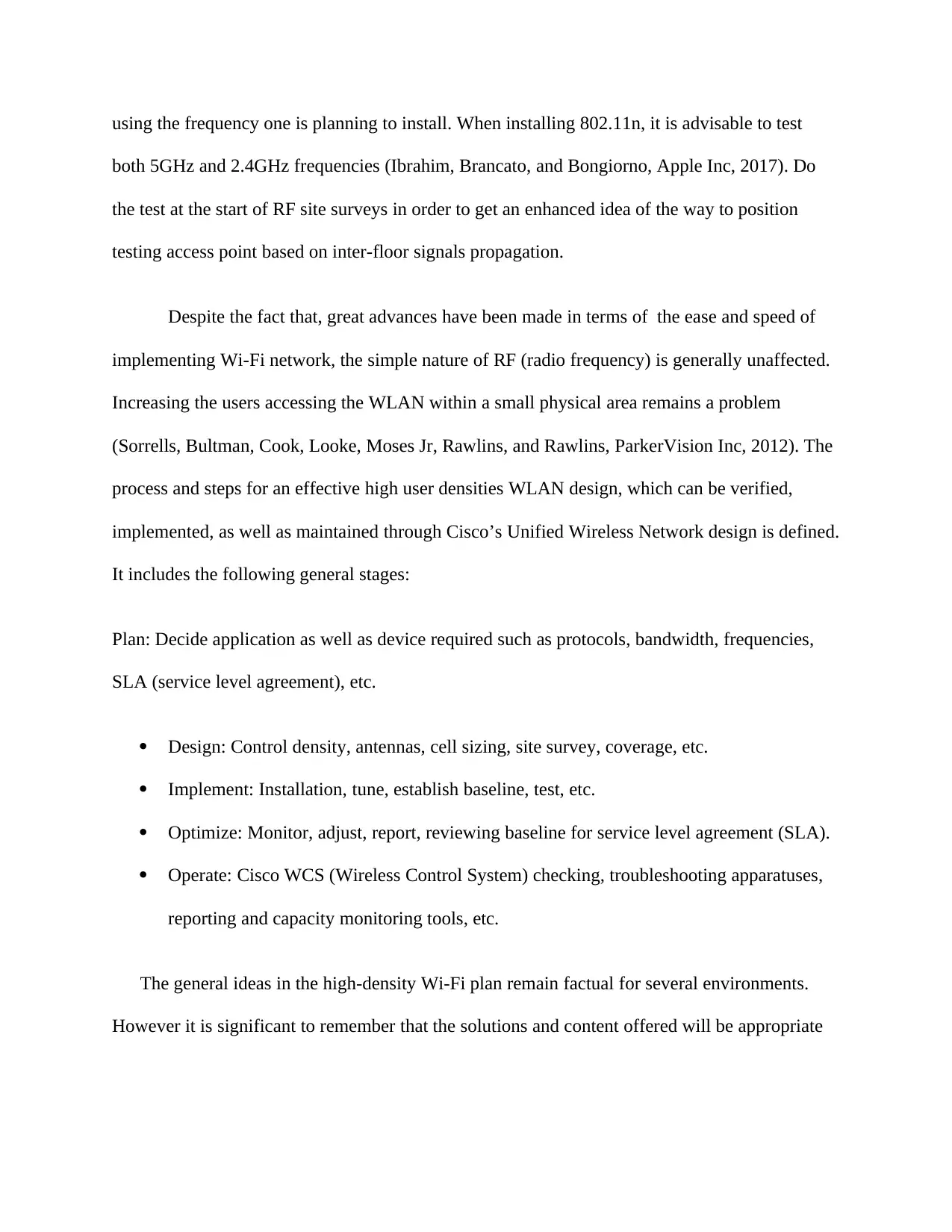
using the frequency one is planning to install. When installing 802.11n, it is advisable to test
both 5GHz and 2.4GHz frequencies (Ibrahim, Brancato, and Bongiorno, Apple Inc, 2017). Do
the test at the start of RF site surveys in order to get an enhanced idea of the way to position
testing access point based on inter-floor signals propagation.
Despite the fact that, great advances have been made in terms of the ease and speed of
implementing Wi-Fi network, the simple nature of RF (radio frequency) is generally unaffected.
Increasing the users accessing the WLAN within a small physical area remains a problem
(Sorrells, Bultman, Cook, Looke, Moses Jr, Rawlins, and Rawlins, ParkerVision Inc, 2012). The
process and steps for an effective high user densities WLAN design, which can be verified,
implemented, as well as maintained through Cisco’s Unified Wireless Network design is defined.
It includes the following general stages:
Plan: Decide application as well as device required such as protocols, bandwidth, frequencies,
SLA (service level agreement), etc.
Design: Control density, antennas, cell sizing, site survey, coverage, etc.
Implement: Installation, tune, establish baseline, test, etc.
Optimize: Monitor, adjust, report, reviewing baseline for service level agreement (SLA).
Operate: Cisco WCS (Wireless Control System) checking, troubleshooting apparatuses,
reporting and capacity monitoring tools, etc.
The general ideas in the high-density Wi-Fi plan remain factual for several environments.
However it is significant to remember that the solutions and content offered will be appropriate
both 5GHz and 2.4GHz frequencies (Ibrahim, Brancato, and Bongiorno, Apple Inc, 2017). Do
the test at the start of RF site surveys in order to get an enhanced idea of the way to position
testing access point based on inter-floor signals propagation.
Despite the fact that, great advances have been made in terms of the ease and speed of
implementing Wi-Fi network, the simple nature of RF (radio frequency) is generally unaffected.
Increasing the users accessing the WLAN within a small physical area remains a problem
(Sorrells, Bultman, Cook, Looke, Moses Jr, Rawlins, and Rawlins, ParkerVision Inc, 2012). The
process and steps for an effective high user densities WLAN design, which can be verified,
implemented, as well as maintained through Cisco’s Unified Wireless Network design is defined.
It includes the following general stages:
Plan: Decide application as well as device required such as protocols, bandwidth, frequencies,
SLA (service level agreement), etc.
Design: Control density, antennas, cell sizing, site survey, coverage, etc.
Implement: Installation, tune, establish baseline, test, etc.
Optimize: Monitor, adjust, report, reviewing baseline for service level agreement (SLA).
Operate: Cisco WCS (Wireless Control System) checking, troubleshooting apparatuses,
reporting and capacity monitoring tools, etc.
The general ideas in the high-density Wi-Fi plan remain factual for several environments.
However it is significant to remember that the solutions and content offered will be appropriate
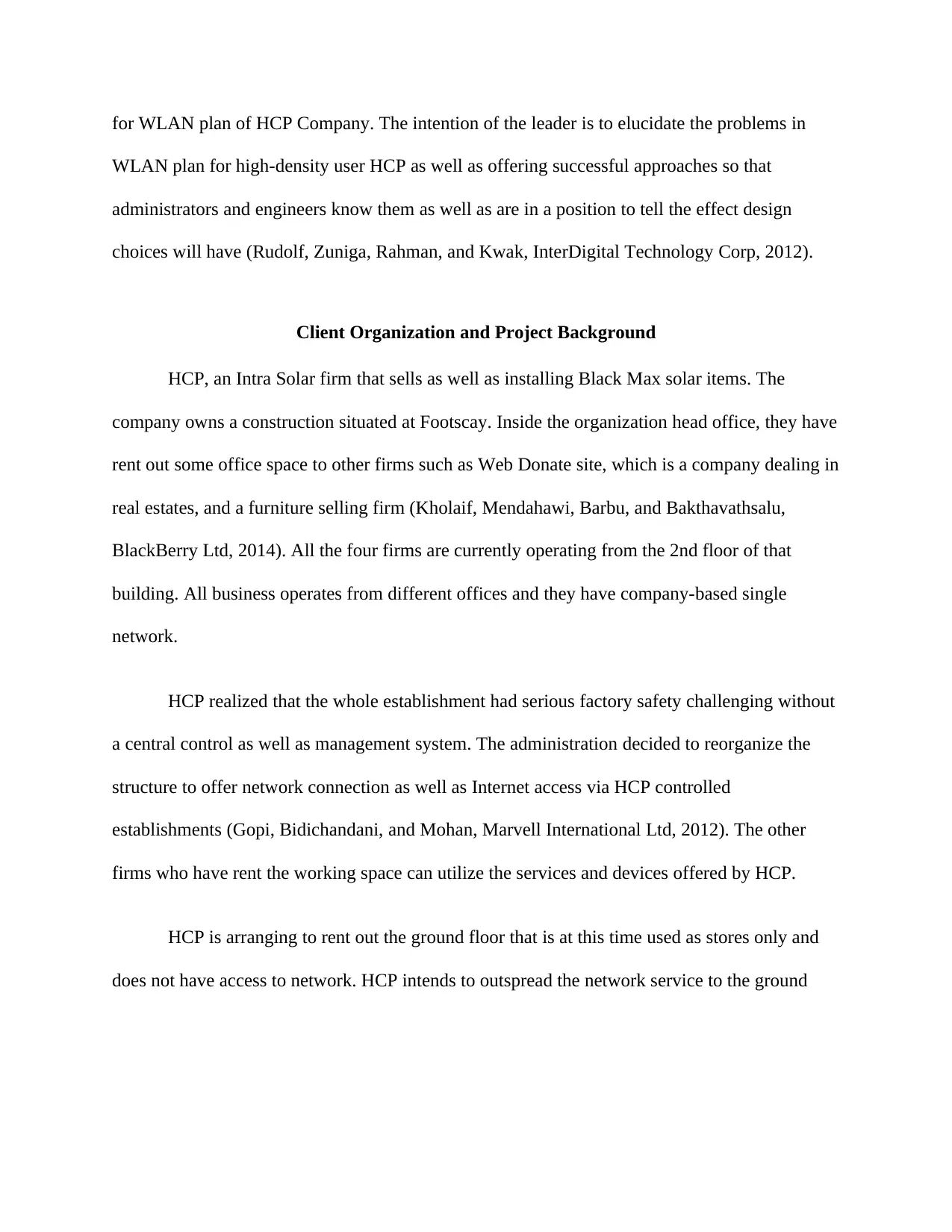
for WLAN plan of HCP Company. The intention of the leader is to elucidate the problems in
WLAN plan for high-density user HCP as well as offering successful approaches so that
administrators and engineers know them as well as are in a position to tell the effect design
choices will have (Rudolf, Zuniga, Rahman, and Kwak, InterDigital Technology Corp, 2012).
Client Organization and Project Background
HCP, an Intra Solar firm that sells as well as installing Black Max solar items. The
company owns a construction situated at Footscay. Inside the organization head office, they have
rent out some office space to other firms such as Web Donate site, which is a company dealing in
real estates, and a furniture selling firm (Kholaif, Mendahawi, Barbu, and Bakthavathsalu,
BlackBerry Ltd, 2014). All the four firms are currently operating from the 2nd floor of that
building. All business operates from different offices and they have company-based single
network.
HCP realized that the whole establishment had serious factory safety challenging without
a central control as well as management system. The administration decided to reorganize the
structure to offer network connection as well as Internet access via HCP controlled
establishments (Gopi, Bidichandani, and Mohan, Marvell International Ltd, 2012). The other
firms who have rent the working space can utilize the services and devices offered by HCP.
HCP is arranging to rent out the ground floor that is at this time used as stores only and
does not have access to network. HCP intends to outspread the network service to the ground
WLAN plan for high-density user HCP as well as offering successful approaches so that
administrators and engineers know them as well as are in a position to tell the effect design
choices will have (Rudolf, Zuniga, Rahman, and Kwak, InterDigital Technology Corp, 2012).
Client Organization and Project Background
HCP, an Intra Solar firm that sells as well as installing Black Max solar items. The
company owns a construction situated at Footscay. Inside the organization head office, they have
rent out some office space to other firms such as Web Donate site, which is a company dealing in
real estates, and a furniture selling firm (Kholaif, Mendahawi, Barbu, and Bakthavathsalu,
BlackBerry Ltd, 2014). All the four firms are currently operating from the 2nd floor of that
building. All business operates from different offices and they have company-based single
network.
HCP realized that the whole establishment had serious factory safety challenging without
a central control as well as management system. The administration decided to reorganize the
structure to offer network connection as well as Internet access via HCP controlled
establishments (Gopi, Bidichandani, and Mohan, Marvell International Ltd, 2012). The other
firms who have rent the working space can utilize the services and devices offered by HCP.
HCP is arranging to rent out the ground floor that is at this time used as stores only and
does not have access to network. HCP intends to outspread the network service to the ground
Paraphrase This Document
Need a fresh take? Get an instant paraphrase of this document with our AI Paraphraser
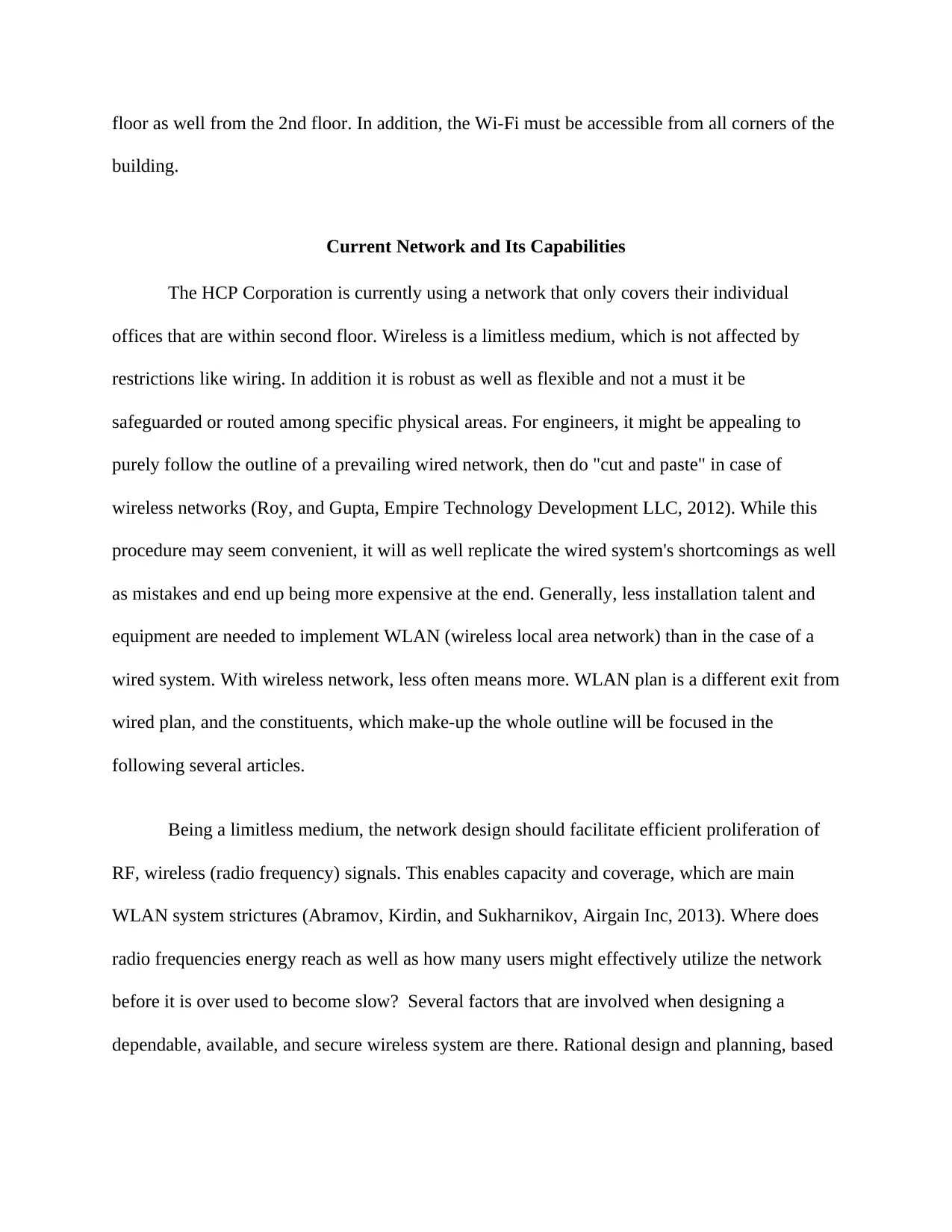
floor as well from the 2nd floor. In addition, the Wi-Fi must be accessible from all corners of the
building.
Current Network and Its Capabilities
The HCP Corporation is currently using a network that only covers their individual
offices that are within second floor. Wireless is a limitless medium, which is not affected by
restrictions like wiring. In addition it is robust as well as flexible and not a must it be
safeguarded or routed among specific physical areas. For engineers, it might be appealing to
purely follow the outline of a prevailing wired network, then do "cut and paste" in case of
wireless networks (Roy, and Gupta, Empire Technology Development LLC, 2012). While this
procedure may seem convenient, it will as well replicate the wired system's shortcomings as well
as mistakes and end up being more expensive at the end. Generally, less installation talent and
equipment are needed to implement WLAN (wireless local area network) than in the case of a
wired system. With wireless network, less often means more. WLAN plan is a different exit from
wired plan, and the constituents, which make-up the whole outline will be focused in the
following several articles.
Being a limitless medium, the network design should facilitate efficient proliferation of
RF, wireless (radio frequency) signals. This enables capacity and coverage, which are main
WLAN system strictures (Abramov, Kirdin, and Sukharnikov, Airgain Inc, 2013). Where does
radio frequencies energy reach as well as how many users might effectively utilize the network
before it is over used to become slow? Several factors that are involved when designing a
dependable, available, and secure wireless system are there. Rational design and planning, based
building.
Current Network and Its Capabilities
The HCP Corporation is currently using a network that only covers their individual
offices that are within second floor. Wireless is a limitless medium, which is not affected by
restrictions like wiring. In addition it is robust as well as flexible and not a must it be
safeguarded or routed among specific physical areas. For engineers, it might be appealing to
purely follow the outline of a prevailing wired network, then do "cut and paste" in case of
wireless networks (Roy, and Gupta, Empire Technology Development LLC, 2012). While this
procedure may seem convenient, it will as well replicate the wired system's shortcomings as well
as mistakes and end up being more expensive at the end. Generally, less installation talent and
equipment are needed to implement WLAN (wireless local area network) than in the case of a
wired system. With wireless network, less often means more. WLAN plan is a different exit from
wired plan, and the constituents, which make-up the whole outline will be focused in the
following several articles.
Being a limitless medium, the network design should facilitate efficient proliferation of
RF, wireless (radio frequency) signals. This enables capacity and coverage, which are main
WLAN system strictures (Abramov, Kirdin, and Sukharnikov, Airgain Inc, 2013). Where does
radio frequencies energy reach as well as how many users might effectively utilize the network
before it is over used to become slow? Several factors that are involved when designing a
dependable, available, and secure wireless system are there. Rational design and planning, based
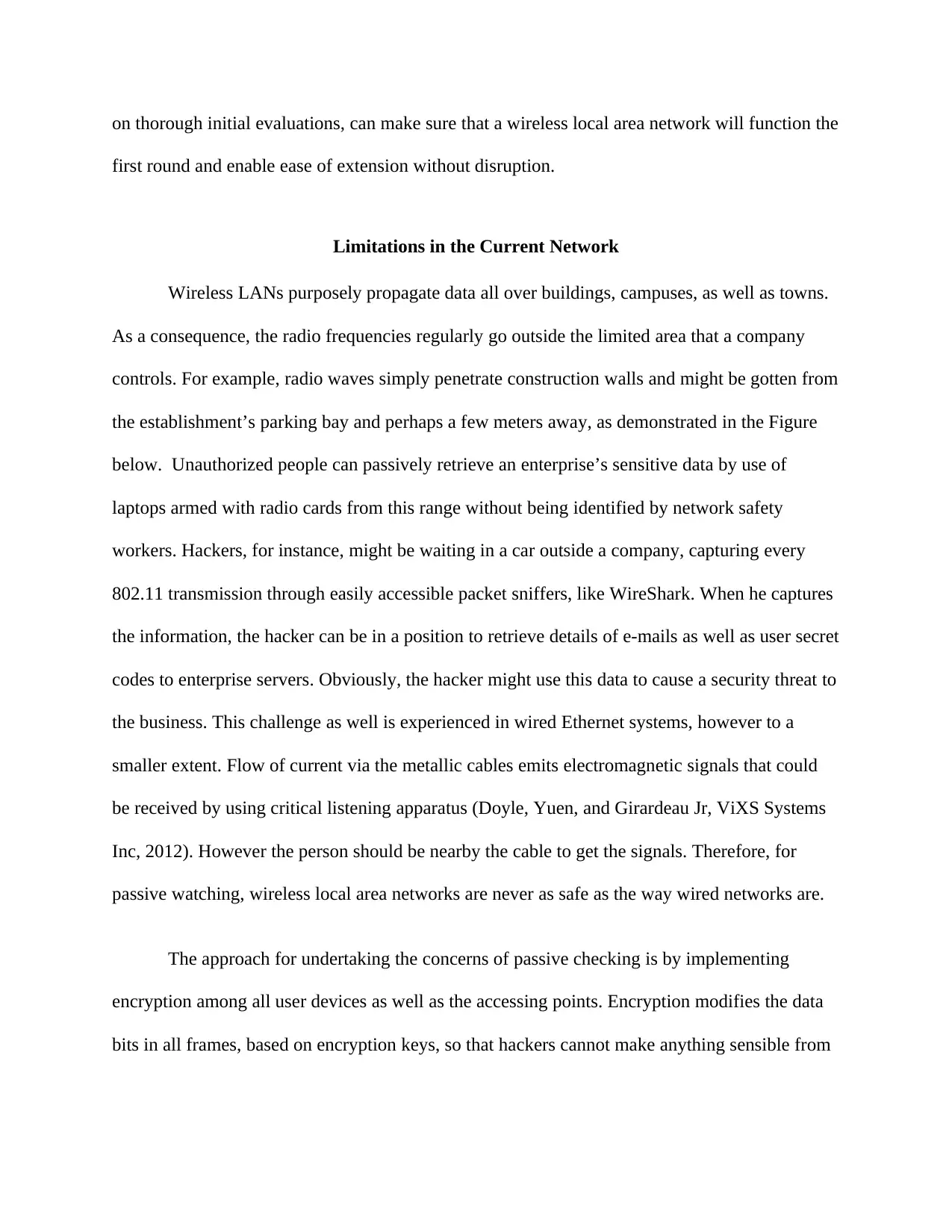
on thorough initial evaluations, can make sure that a wireless local area network will function the
first round and enable ease of extension without disruption.
Limitations in the Current Network
Wireless LANs purposely propagate data all over buildings, campuses, as well as towns.
As a consequence, the radio frequencies regularly go outside the limited area that a company
controls. For example, radio waves simply penetrate construction walls and might be gotten from
the establishment’s parking bay and perhaps a few meters away, as demonstrated in the Figure
below. Unauthorized people can passively retrieve an enterprise’s sensitive data by use of
laptops armed with radio cards from this range without being identified by network safety
workers. Hackers, for instance, might be waiting in a car outside a company, capturing every
802.11 transmission through easily accessible packet sniffers, like WireShark. When he captures
the information, the hacker can be in a position to retrieve details of e-mails as well as user secret
codes to enterprise servers. Obviously, the hacker might use this data to cause a security threat to
the business. This challenge as well is experienced in wired Ethernet systems, however to a
smaller extent. Flow of current via the metallic cables emits electromagnetic signals that could
be received by using critical listening apparatus (Doyle, Yuen, and Girardeau Jr, ViXS Systems
Inc, 2012). However the person should be nearby the cable to get the signals. Therefore, for
passive watching, wireless local area networks are never as safe as the way wired networks are.
The approach for undertaking the concerns of passive checking is by implementing
encryption among all user devices as well as the accessing points. Encryption modifies the data
bits in all frames, based on encryption keys, so that hackers cannot make anything sensible from
first round and enable ease of extension without disruption.
Limitations in the Current Network
Wireless LANs purposely propagate data all over buildings, campuses, as well as towns.
As a consequence, the radio frequencies regularly go outside the limited area that a company
controls. For example, radio waves simply penetrate construction walls and might be gotten from
the establishment’s parking bay and perhaps a few meters away, as demonstrated in the Figure
below. Unauthorized people can passively retrieve an enterprise’s sensitive data by use of
laptops armed with radio cards from this range without being identified by network safety
workers. Hackers, for instance, might be waiting in a car outside a company, capturing every
802.11 transmission through easily accessible packet sniffers, like WireShark. When he captures
the information, the hacker can be in a position to retrieve details of e-mails as well as user secret
codes to enterprise servers. Obviously, the hacker might use this data to cause a security threat to
the business. This challenge as well is experienced in wired Ethernet systems, however to a
smaller extent. Flow of current via the metallic cables emits electromagnetic signals that could
be received by using critical listening apparatus (Doyle, Yuen, and Girardeau Jr, ViXS Systems
Inc, 2012). However the person should be nearby the cable to get the signals. Therefore, for
passive watching, wireless local area networks are never as safe as the way wired networks are.
The approach for undertaking the concerns of passive checking is by implementing
encryption among all user devices as well as the accessing points. Encryption modifies the data
bits in all frames, based on encryption keys, so that hackers cannot make anything sensible from
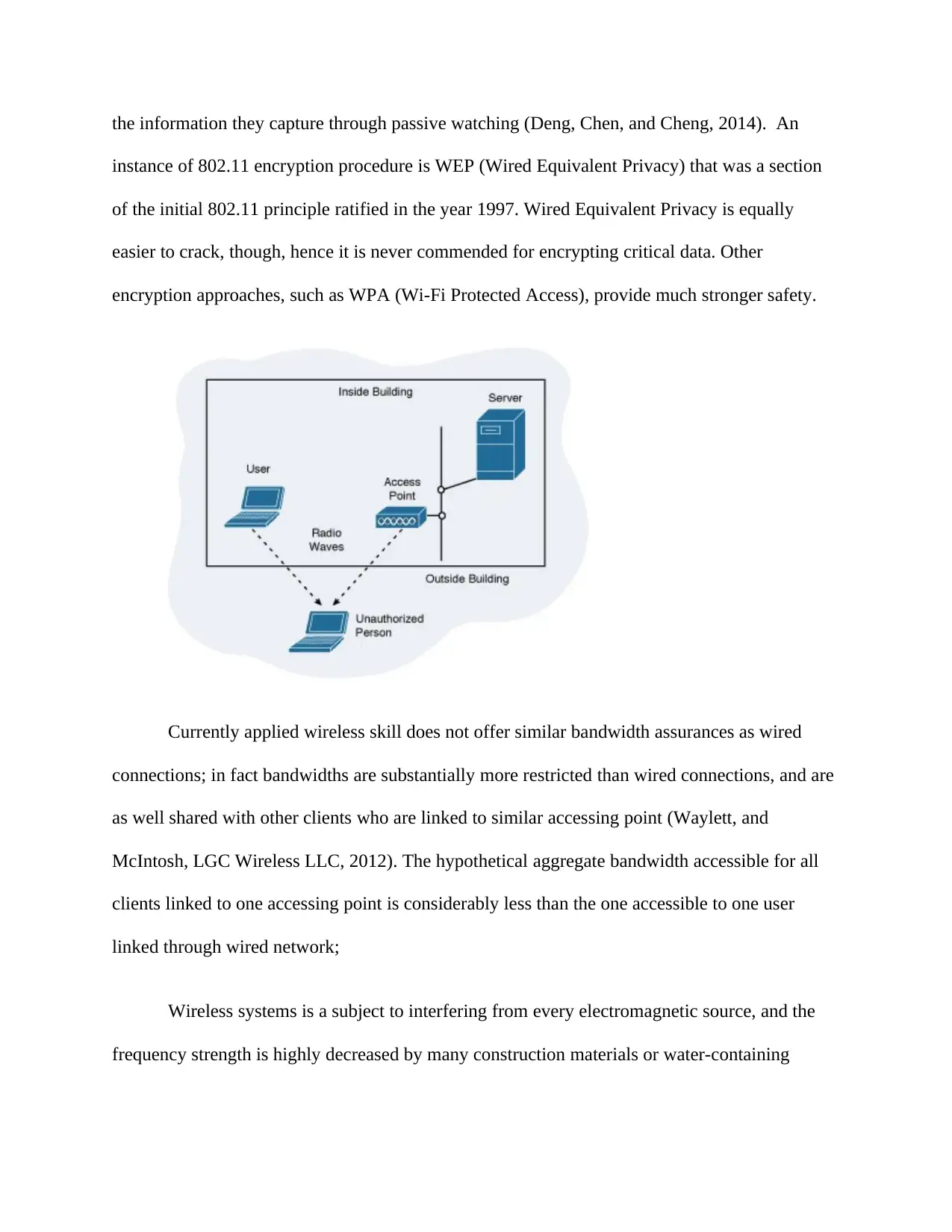
the information they capture through passive watching (Deng, Chen, and Cheng, 2014). An
instance of 802.11 encryption procedure is WEP (Wired Equivalent Privacy) that was a section
of the initial 802.11 principle ratified in the year 1997. Wired Equivalent Privacy is equally
easier to crack, though, hence it is never commended for encrypting critical data. Other
encryption approaches, such as WPA (Wi-Fi Protected Access), provide much stronger safety.
Currently applied wireless skill does not offer similar bandwidth assurances as wired
connections; in fact bandwidths are substantially more restricted than wired connections, and are
as well shared with other clients who are linked to similar accessing point (Waylett, and
McIntosh, LGC Wireless LLC, 2012). The hypothetical aggregate bandwidth accessible for all
clients linked to one accessing point is considerably less than the one accessible to one user
linked through wired network;
Wireless systems is a subject to interfering from every electromagnetic source, and the
frequency strength is highly decreased by many construction materials or water-containing
instance of 802.11 encryption procedure is WEP (Wired Equivalent Privacy) that was a section
of the initial 802.11 principle ratified in the year 1997. Wired Equivalent Privacy is equally
easier to crack, though, hence it is never commended for encrypting critical data. Other
encryption approaches, such as WPA (Wi-Fi Protected Access), provide much stronger safety.
Currently applied wireless skill does not offer similar bandwidth assurances as wired
connections; in fact bandwidths are substantially more restricted than wired connections, and are
as well shared with other clients who are linked to similar accessing point (Waylett, and
McIntosh, LGC Wireless LLC, 2012). The hypothetical aggregate bandwidth accessible for all
clients linked to one accessing point is considerably less than the one accessible to one user
linked through wired network;
Wireless systems is a subject to interfering from every electromagnetic source, and the
frequency strength is highly decreased by many construction materials or water-containing
Secure Best Marks with AI Grader
Need help grading? Try our AI Grader for instant feedback on your assignments.
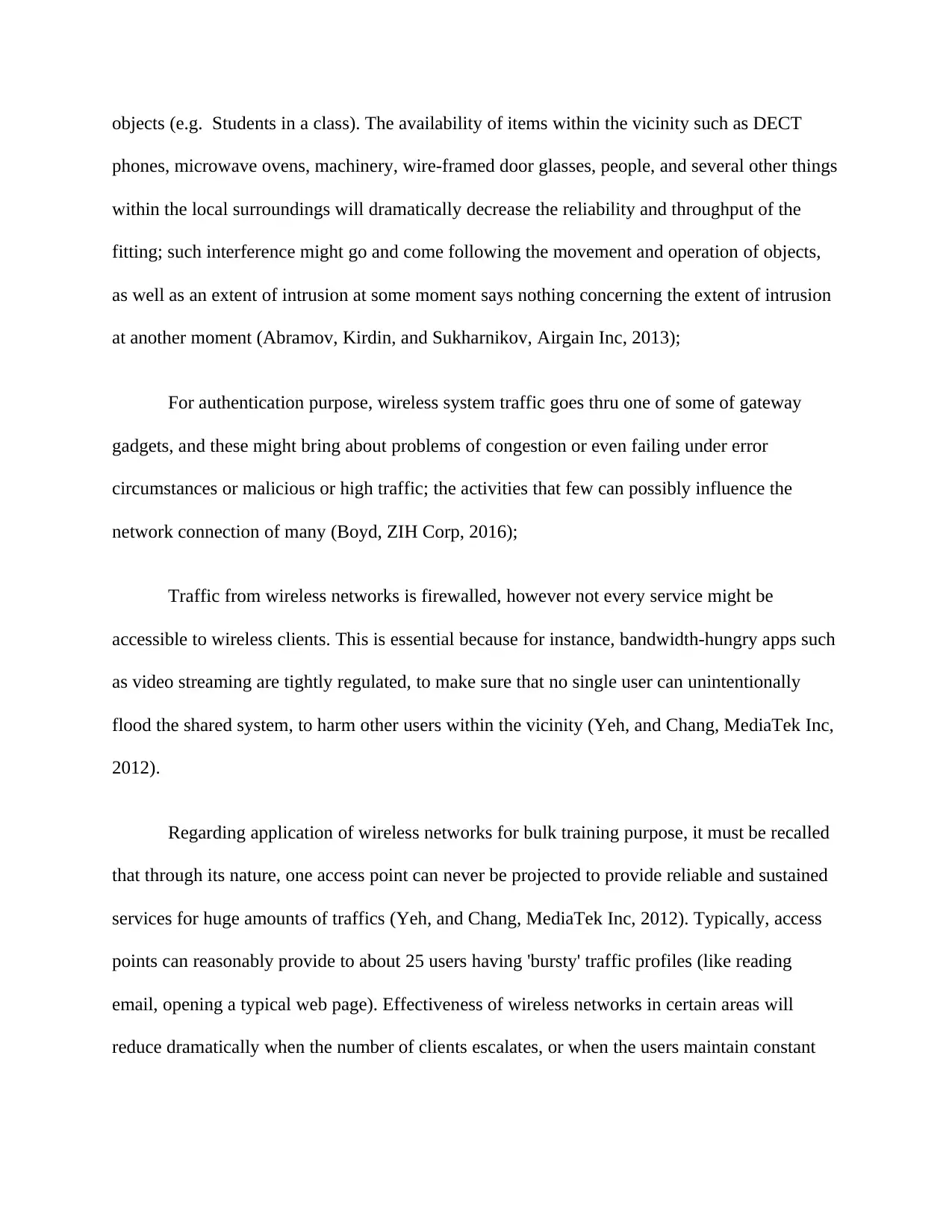
objects (e.g. Students in a class). The availability of items within the vicinity such as DECT
phones, microwave ovens, machinery, wire-framed door glasses, people, and several other things
within the local surroundings will dramatically decrease the reliability and throughput of the
fitting; such interference might go and come following the movement and operation of objects,
as well as an extent of intrusion at some moment says nothing concerning the extent of intrusion
at another moment (Abramov, Kirdin, and Sukharnikov, Airgain Inc, 2013);
For authentication purpose, wireless system traffic goes thru one of some of gateway
gadgets, and these might bring about problems of congestion or even failing under error
circumstances or malicious or high traffic; the activities that few can possibly influence the
network connection of many (Boyd, ZIH Corp, 2016);
Traffic from wireless networks is firewalled, however not every service might be
accessible to wireless clients. This is essential because for instance, bandwidth-hungry apps such
as video streaming are tightly regulated, to make sure that no single user can unintentionally
flood the shared system, to harm other users within the vicinity (Yeh, and Chang, MediaTek Inc,
2012).
Regarding application of wireless networks for bulk training purpose, it must be recalled
that through its nature, one access point can never be projected to provide reliable and sustained
services for huge amounts of traffics (Yeh, and Chang, MediaTek Inc, 2012). Typically, access
points can reasonably provide to about 25 users having 'bursty' traffic profiles (like reading
email, opening a typical web page). Effectiveness of wireless networks in certain areas will
reduce dramatically when the number of clients escalates, or when the users maintain constant
phones, microwave ovens, machinery, wire-framed door glasses, people, and several other things
within the local surroundings will dramatically decrease the reliability and throughput of the
fitting; such interference might go and come following the movement and operation of objects,
as well as an extent of intrusion at some moment says nothing concerning the extent of intrusion
at another moment (Abramov, Kirdin, and Sukharnikov, Airgain Inc, 2013);
For authentication purpose, wireless system traffic goes thru one of some of gateway
gadgets, and these might bring about problems of congestion or even failing under error
circumstances or malicious or high traffic; the activities that few can possibly influence the
network connection of many (Boyd, ZIH Corp, 2016);
Traffic from wireless networks is firewalled, however not every service might be
accessible to wireless clients. This is essential because for instance, bandwidth-hungry apps such
as video streaming are tightly regulated, to make sure that no single user can unintentionally
flood the shared system, to harm other users within the vicinity (Yeh, and Chang, MediaTek Inc,
2012).
Regarding application of wireless networks for bulk training purpose, it must be recalled
that through its nature, one access point can never be projected to provide reliable and sustained
services for huge amounts of traffics (Yeh, and Chang, MediaTek Inc, 2012). Typically, access
points can reasonably provide to about 25 users having 'bursty' traffic profiles (like reading
email, opening a typical web page). Effectiveness of wireless networks in certain areas will
reduce dramatically when the number of clients escalates, or when the users maintain constant
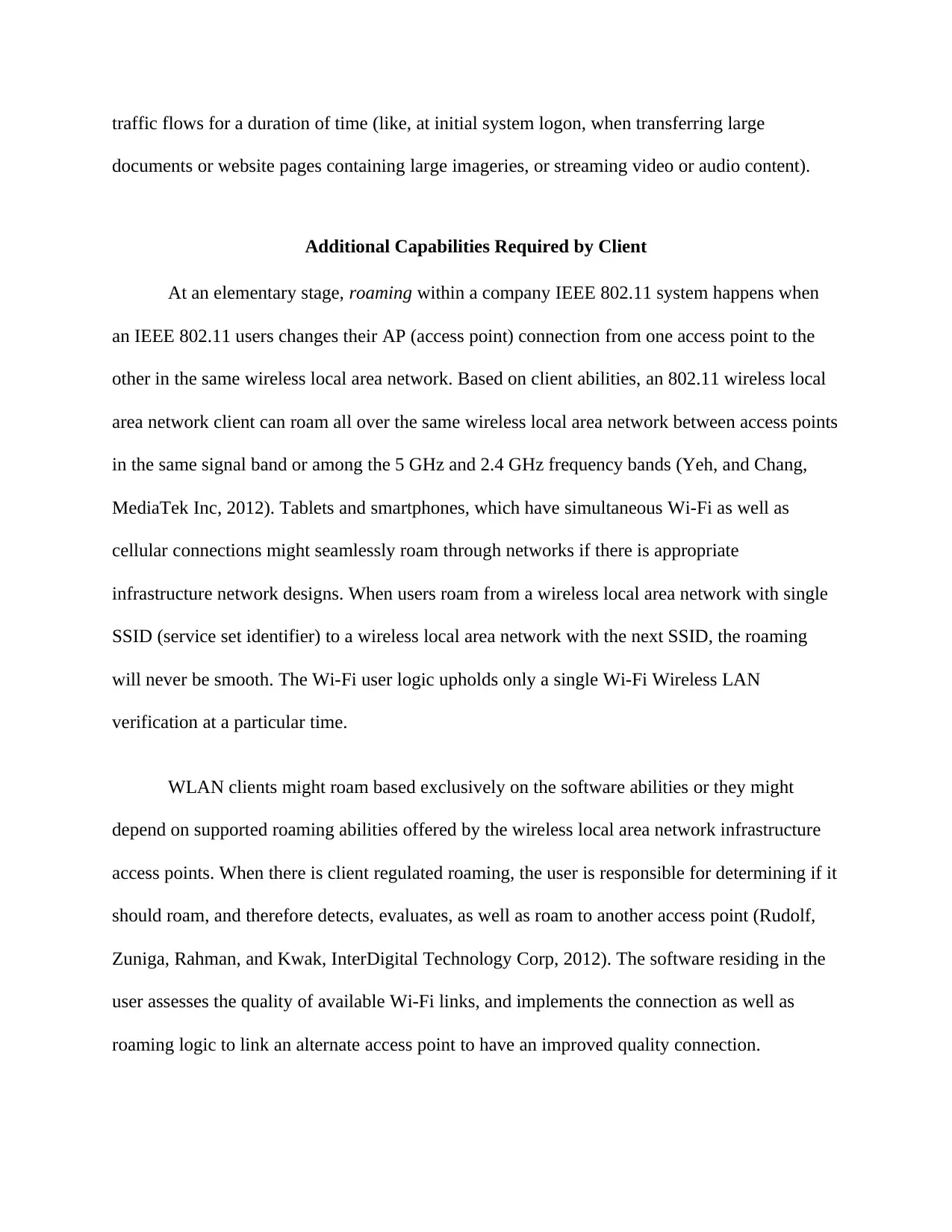
traffic flows for a duration of time (like, at initial system logon, when transferring large
documents or website pages containing large imageries, or streaming video or audio content).
Additional Capabilities Required by Client
At an elementary stage, roaming within a company IEEE 802.11 system happens when
an IEEE 802.11 users changes their AP (access point) connection from one access point to the
other in the same wireless local area network. Based on client abilities, an 802.11 wireless local
area network client can roam all over the same wireless local area network between access points
in the same signal band or among the 5 GHz and 2.4 GHz frequency bands (Yeh, and Chang,
MediaTek Inc, 2012). Tablets and smartphones, which have simultaneous Wi-Fi as well as
cellular connections might seamlessly roam through networks if there is appropriate
infrastructure network designs. When users roam from a wireless local area network with single
SSID (service set identifier) to a wireless local area network with the next SSID, the roaming
will never be smooth. The Wi-Fi user logic upholds only a single Wi-Fi Wireless LAN
verification at a particular time.
WLAN clients might roam based exclusively on the software abilities or they might
depend on supported roaming abilities offered by the wireless local area network infrastructure
access points. When there is client regulated roaming, the user is responsible for determining if it
should roam, and therefore detects, evaluates, as well as roam to another access point (Rudolf,
Zuniga, Rahman, and Kwak, InterDigital Technology Corp, 2012). The software residing in the
user assesses the quality of available Wi-Fi links, and implements the connection as well as
roaming logic to link an alternate access point to have an improved quality connection.
documents or website pages containing large imageries, or streaming video or audio content).
Additional Capabilities Required by Client
At an elementary stage, roaming within a company IEEE 802.11 system happens when
an IEEE 802.11 users changes their AP (access point) connection from one access point to the
other in the same wireless local area network. Based on client abilities, an 802.11 wireless local
area network client can roam all over the same wireless local area network between access points
in the same signal band or among the 5 GHz and 2.4 GHz frequency bands (Yeh, and Chang,
MediaTek Inc, 2012). Tablets and smartphones, which have simultaneous Wi-Fi as well as
cellular connections might seamlessly roam through networks if there is appropriate
infrastructure network designs. When users roam from a wireless local area network with single
SSID (service set identifier) to a wireless local area network with the next SSID, the roaming
will never be smooth. The Wi-Fi user logic upholds only a single Wi-Fi Wireless LAN
verification at a particular time.
WLAN clients might roam based exclusively on the software abilities or they might
depend on supported roaming abilities offered by the wireless local area network infrastructure
access points. When there is client regulated roaming, the user is responsible for determining if it
should roam, and therefore detects, evaluates, as well as roam to another access point (Rudolf,
Zuniga, Rahman, and Kwak, InterDigital Technology Corp, 2012). The software residing in the
user assesses the quality of available Wi-Fi links, and implements the connection as well as
roaming logic to link an alternate access point to have an improved quality connection.
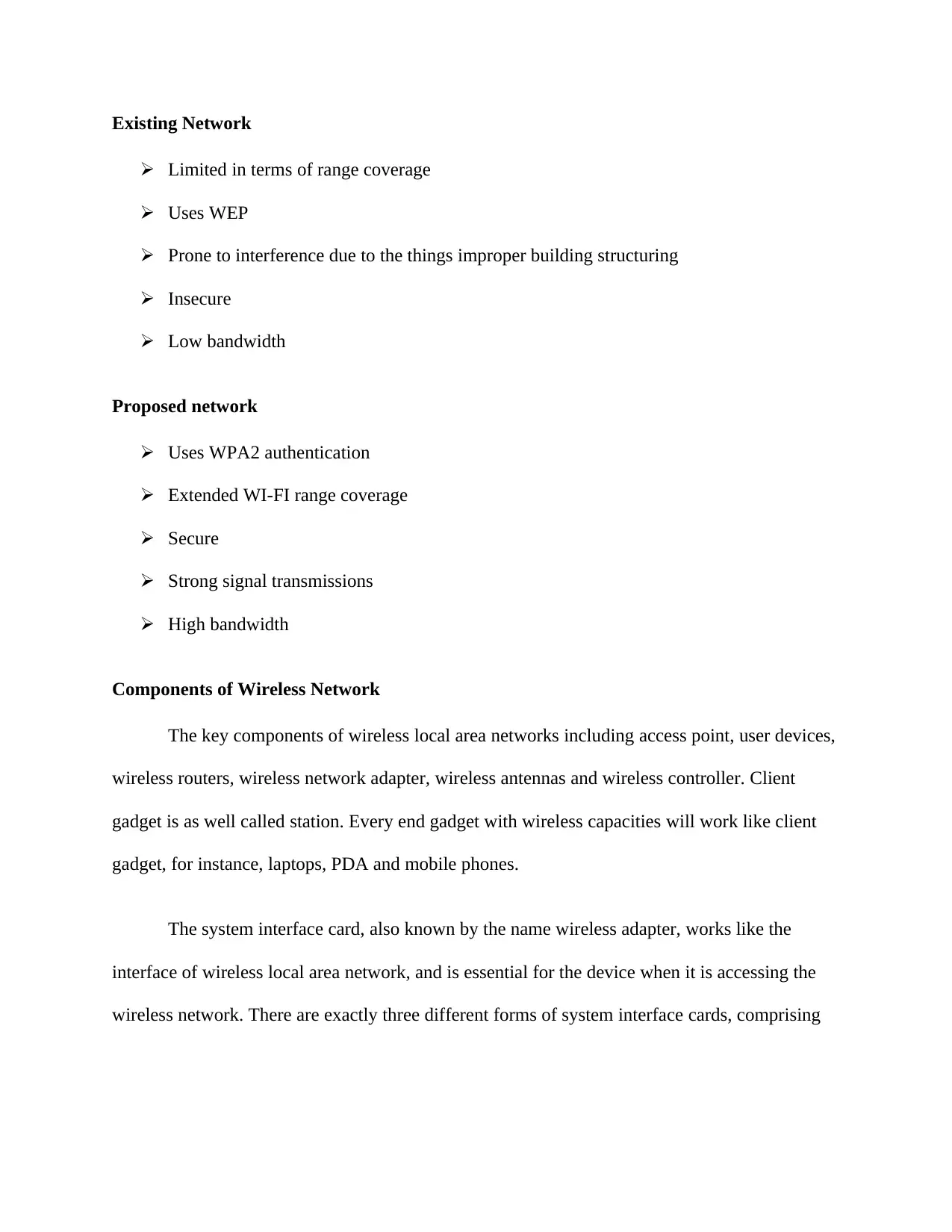
Existing Network
Limited in terms of range coverage
Uses WEP
Prone to interference due to the things improper building structuring
Insecure
Low bandwidth
Proposed network
Uses WPA2 authentication
Extended WI-FI range coverage
Secure
Strong signal transmissions
High bandwidth
Components of Wireless Network
The key components of wireless local area networks including access point, user devices,
wireless routers, wireless network adapter, wireless antennas and wireless controller. Client
gadget is as well called station. Every end gadget with wireless capacities will work like client
gadget, for instance, laptops, PDA and mobile phones.
The system interface card, also known by the name wireless adapter, works like the
interface of wireless local area network, and is essential for the device when it is accessing the
wireless network. There are exactly three different forms of system interface cards, comprising
Limited in terms of range coverage
Uses WEP
Prone to interference due to the things improper building structuring
Insecure
Low bandwidth
Proposed network
Uses WPA2 authentication
Extended WI-FI range coverage
Secure
Strong signal transmissions
High bandwidth
Components of Wireless Network
The key components of wireless local area networks including access point, user devices,
wireless routers, wireless network adapter, wireless antennas and wireless controller. Client
gadget is as well called station. Every end gadget with wireless capacities will work like client
gadget, for instance, laptops, PDA and mobile phones.
The system interface card, also known by the name wireless adapter, works like the
interface of wireless local area network, and is essential for the device when it is accessing the
wireless network. There are exactly three different forms of system interface cards, comprising
Paraphrase This Document
Need a fresh take? Get an instant paraphrase of this document with our AI Paraphraser
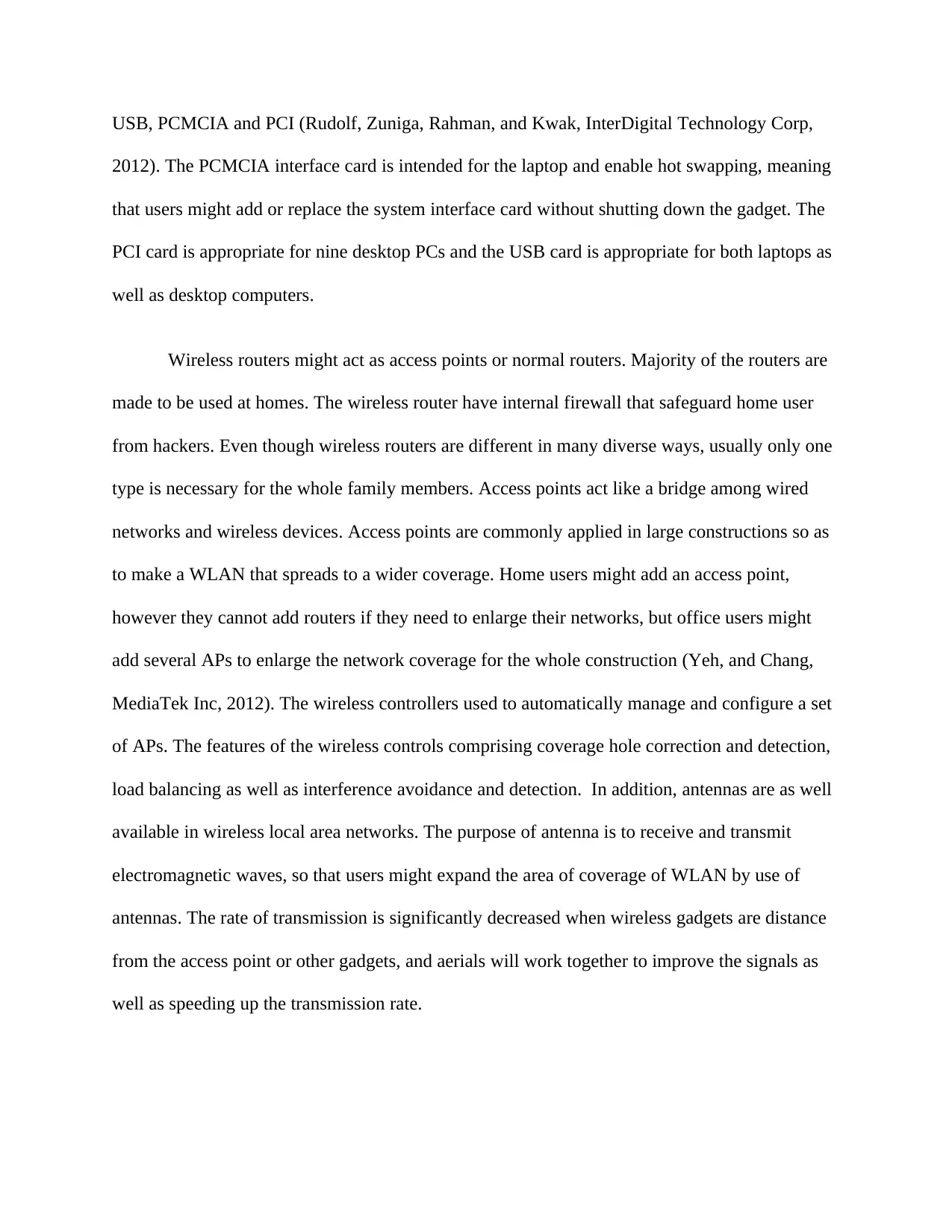
USB, PCMCIA and PCI (Rudolf, Zuniga, Rahman, and Kwak, InterDigital Technology Corp,
2012). The PCMCIA interface card is intended for the laptop and enable hot swapping, meaning
that users might add or replace the system interface card without shutting down the gadget. The
PCI card is appropriate for nine desktop PCs and the USB card is appropriate for both laptops as
well as desktop computers.
Wireless routers might act as access points or normal routers. Majority of the routers are
made to be used at homes. The wireless router have internal firewall that safeguard home user
from hackers. Even though wireless routers are different in many diverse ways, usually only one
type is necessary for the whole family members. Access points act like a bridge among wired
networks and wireless devices. Access points are commonly applied in large constructions so as
to make a WLAN that spreads to a wider coverage. Home users might add an access point,
however they cannot add routers if they need to enlarge their networks, but office users might
add several APs to enlarge the network coverage for the whole construction (Yeh, and Chang,
MediaTek Inc, 2012). The wireless controllers used to automatically manage and configure a set
of APs. The features of the wireless controls comprising coverage hole correction and detection,
load balancing as well as interference avoidance and detection. In addition, antennas are as well
available in wireless local area networks. The purpose of antenna is to receive and transmit
electromagnetic waves, so that users might expand the area of coverage of WLAN by use of
antennas. The rate of transmission is significantly decreased when wireless gadgets are distance
from the access point or other gadgets, and aerials will work together to improve the signals as
well as speeding up the transmission rate.
2012). The PCMCIA interface card is intended for the laptop and enable hot swapping, meaning
that users might add or replace the system interface card without shutting down the gadget. The
PCI card is appropriate for nine desktop PCs and the USB card is appropriate for both laptops as
well as desktop computers.
Wireless routers might act as access points or normal routers. Majority of the routers are
made to be used at homes. The wireless router have internal firewall that safeguard home user
from hackers. Even though wireless routers are different in many diverse ways, usually only one
type is necessary for the whole family members. Access points act like a bridge among wired
networks and wireless devices. Access points are commonly applied in large constructions so as
to make a WLAN that spreads to a wider coverage. Home users might add an access point,
however they cannot add routers if they need to enlarge their networks, but office users might
add several APs to enlarge the network coverage for the whole construction (Yeh, and Chang,
MediaTek Inc, 2012). The wireless controllers used to automatically manage and configure a set
of APs. The features of the wireless controls comprising coverage hole correction and detection,
load balancing as well as interference avoidance and detection. In addition, antennas are as well
available in wireless local area networks. The purpose of antenna is to receive and transmit
electromagnetic waves, so that users might expand the area of coverage of WLAN by use of
antennas. The rate of transmission is significantly decreased when wireless gadgets are distance
from the access point or other gadgets, and aerials will work together to improve the signals as
well as speeding up the transmission rate.
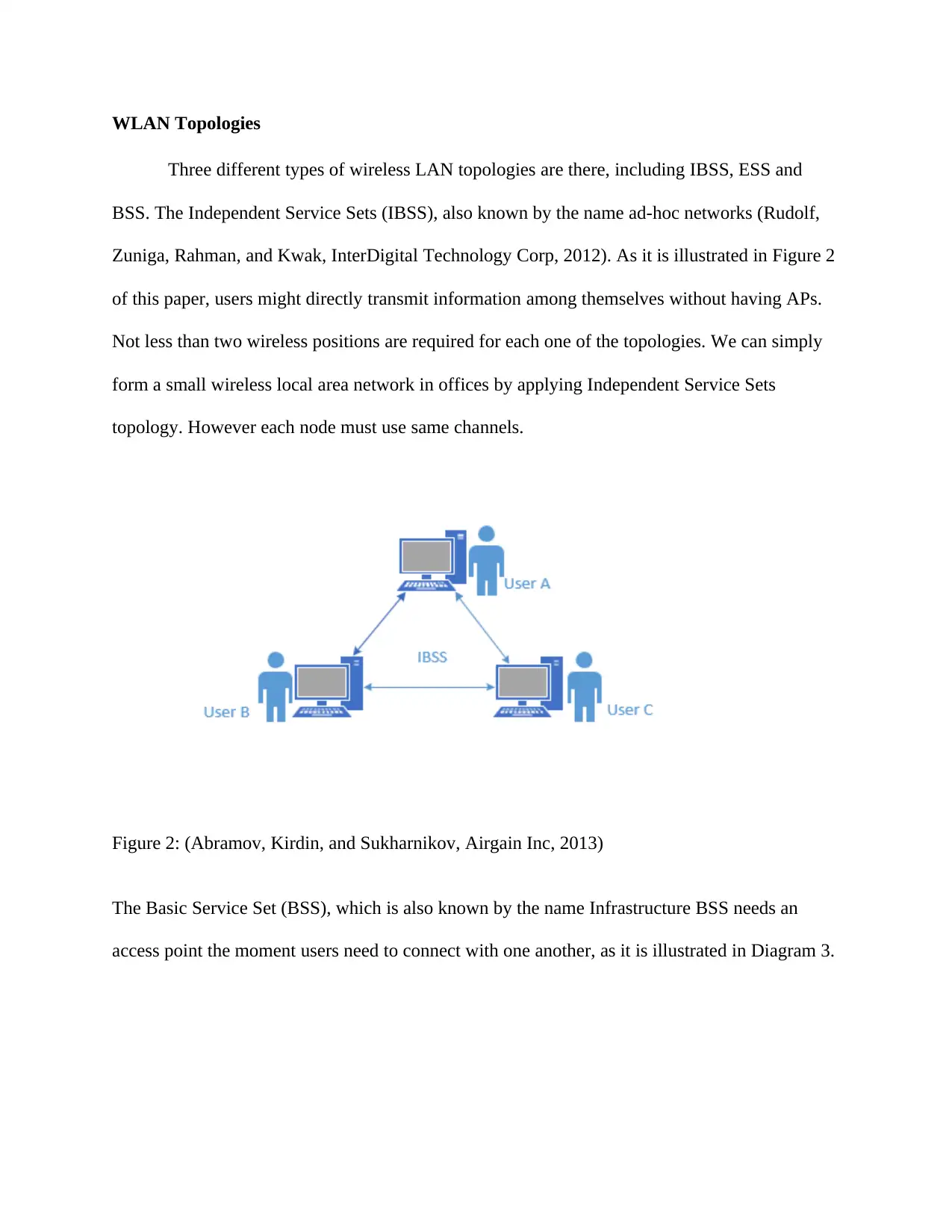
WLAN Topologies
Three different types of wireless LAN topologies are there, including IBSS, ESS and
BSS. The Independent Service Sets (IBSS), also known by the name ad-hoc networks (Rudolf,
Zuniga, Rahman, and Kwak, InterDigital Technology Corp, 2012). As it is illustrated in Figure 2
of this paper, users might directly transmit information among themselves without having APs.
Not less than two wireless positions are required for each one of the topologies. We can simply
form a small wireless local area network in offices by applying Independent Service Sets
topology. However each node must use same channels.
Figure 2: (Abramov, Kirdin, and Sukharnikov, Airgain Inc, 2013)
The Basic Service Set (BSS), which is also known by the name Infrastructure BSS needs an
access point the moment users need to connect with one another, as it is illustrated in Diagram 3.
Three different types of wireless LAN topologies are there, including IBSS, ESS and
BSS. The Independent Service Sets (IBSS), also known by the name ad-hoc networks (Rudolf,
Zuniga, Rahman, and Kwak, InterDigital Technology Corp, 2012). As it is illustrated in Figure 2
of this paper, users might directly transmit information among themselves without having APs.
Not less than two wireless positions are required for each one of the topologies. We can simply
form a small wireless local area network in offices by applying Independent Service Sets
topology. However each node must use same channels.
Figure 2: (Abramov, Kirdin, and Sukharnikov, Airgain Inc, 2013)
The Basic Service Set (BSS), which is also known by the name Infrastructure BSS needs an
access point the moment users need to connect with one another, as it is illustrated in Diagram 3.
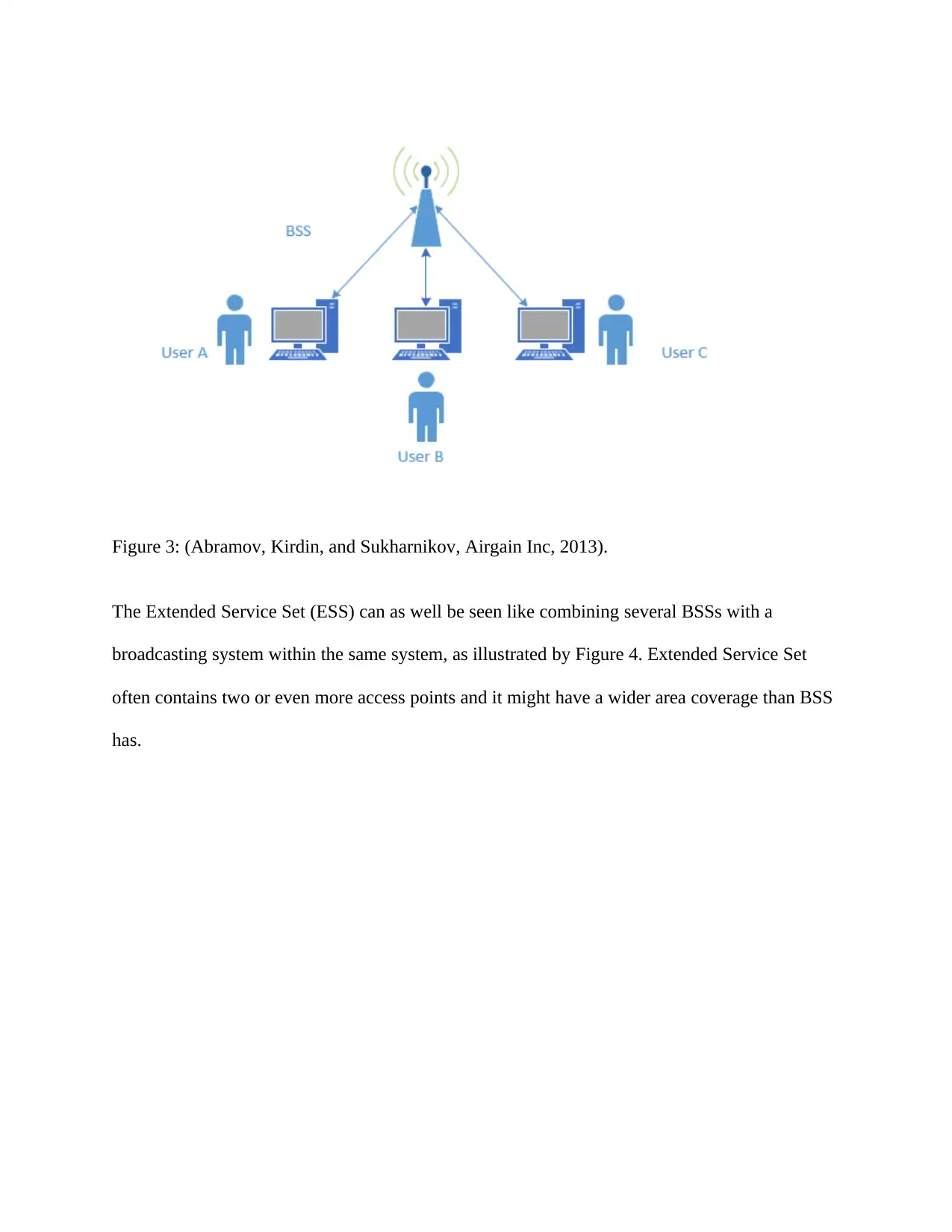
Figure 3: (Abramov, Kirdin, and Sukharnikov, Airgain Inc, 2013).
The Extended Service Set (ESS) can as well be seen like combining several BSSs with a
broadcasting system within the same system, as illustrated by Figure 4. Extended Service Set
often contains two or even more access points and it might have a wider area coverage than BSS
has.
The Extended Service Set (ESS) can as well be seen like combining several BSSs with a
broadcasting system within the same system, as illustrated by Figure 4. Extended Service Set
often contains two or even more access points and it might have a wider area coverage than BSS
has.
Secure Best Marks with AI Grader
Need help grading? Try our AI Grader for instant feedback on your assignments.
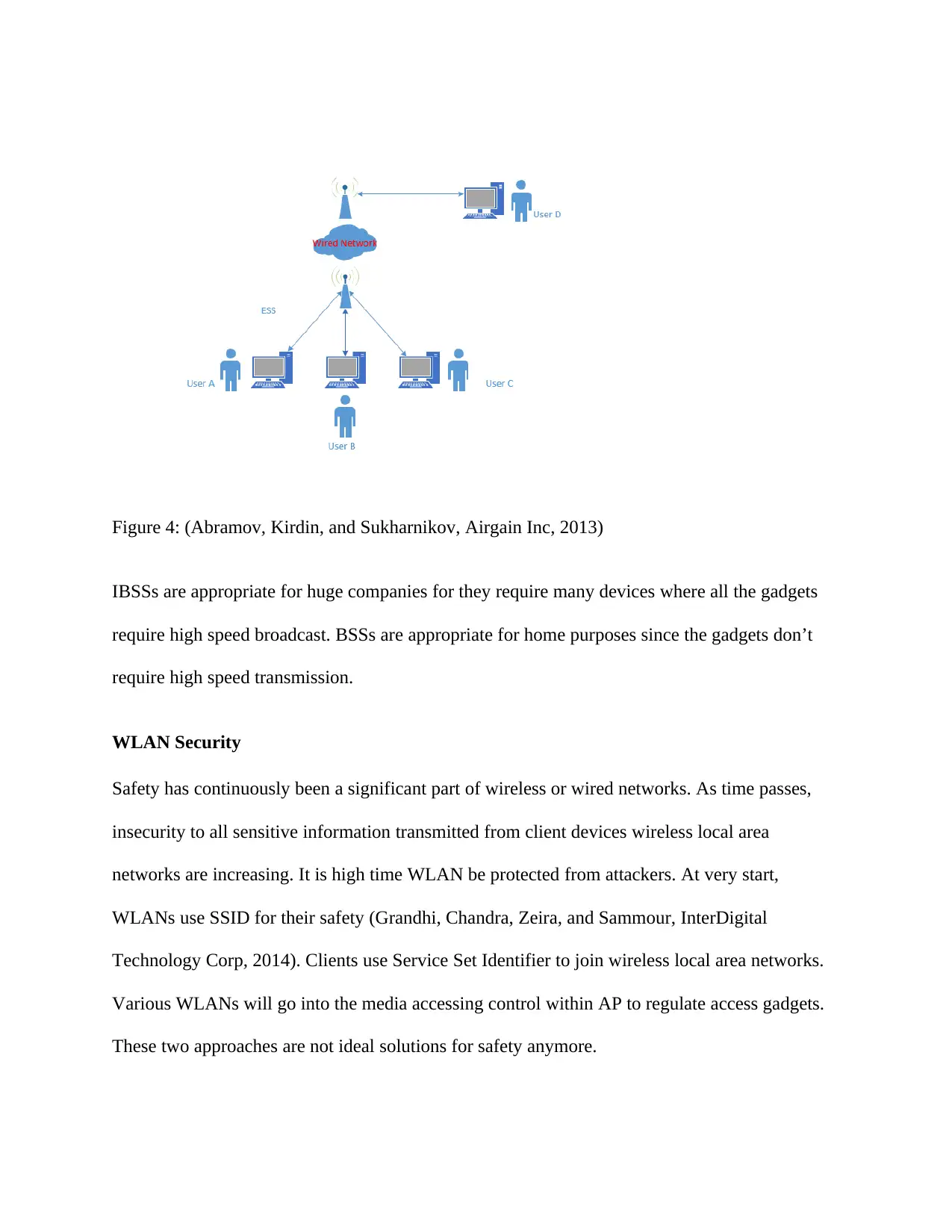
Figure 4: (Abramov, Kirdin, and Sukharnikov, Airgain Inc, 2013)
IBSSs are appropriate for huge companies for they require many devices where all the gadgets
require high speed broadcast. BSSs are appropriate for home purposes since the gadgets don’t
require high speed transmission.
WLAN Security
Safety has continuously been a significant part of wireless or wired networks. As time passes,
insecurity to all sensitive information transmitted from client devices wireless local area
networks are increasing. It is high time WLAN be protected from attackers. At very start,
WLANs use SSID for their safety (Grandhi, Chandra, Zeira, and Sammour, InterDigital
Technology Corp, 2014). Clients use Service Set Identifier to join wireless local area networks.
Various WLANs will go into the media accessing control within AP to regulate access gadgets.
These two approaches are not ideal solutions for safety anymore.
IBSSs are appropriate for huge companies for they require many devices where all the gadgets
require high speed broadcast. BSSs are appropriate for home purposes since the gadgets don’t
require high speed transmission.
WLAN Security
Safety has continuously been a significant part of wireless or wired networks. As time passes,
insecurity to all sensitive information transmitted from client devices wireless local area
networks are increasing. It is high time WLAN be protected from attackers. At very start,
WLANs use SSID for their safety (Grandhi, Chandra, Zeira, and Sammour, InterDigital
Technology Corp, 2014). Clients use Service Set Identifier to join wireless local area networks.
Various WLANs will go into the media accessing control within AP to regulate access gadgets.
These two approaches are not ideal solutions for safety anymore.
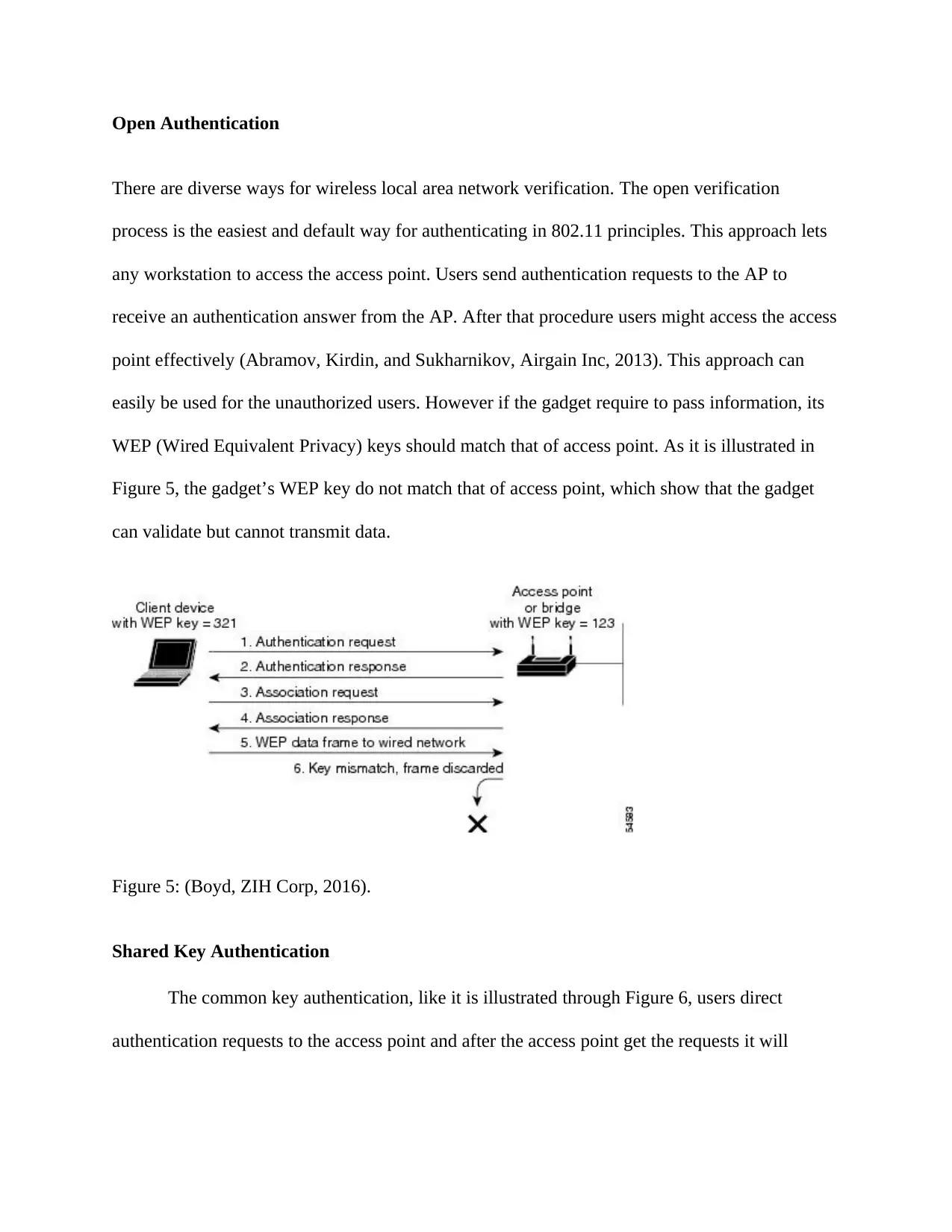
Open Authentication
There are diverse ways for wireless local area network verification. The open verification
process is the easiest and default way for authenticating in 802.11 principles. This approach lets
any workstation to access the access point. Users send authentication requests to the AP to
receive an authentication answer from the AP. After that procedure users might access the access
point effectively (Abramov, Kirdin, and Sukharnikov, Airgain Inc, 2013). This approach can
easily be used for the unauthorized users. However if the gadget require to pass information, its
WEP (Wired Equivalent Privacy) keys should match that of access point. As it is illustrated in
Figure 5, the gadget’s WEP key do not match that of access point, which show that the gadget
can validate but cannot transmit data.
Figure 5: (Boyd, ZIH Corp, 2016).
Shared Key Authentication
The common key authentication, like it is illustrated through Figure 6, users direct
authentication requests to the access point and after the access point get the requests it will
There are diverse ways for wireless local area network verification. The open verification
process is the easiest and default way for authenticating in 802.11 principles. This approach lets
any workstation to access the access point. Users send authentication requests to the AP to
receive an authentication answer from the AP. After that procedure users might access the access
point effectively (Abramov, Kirdin, and Sukharnikov, Airgain Inc, 2013). This approach can
easily be used for the unauthorized users. However if the gadget require to pass information, its
WEP (Wired Equivalent Privacy) keys should match that of access point. As it is illustrated in
Figure 5, the gadget’s WEP key do not match that of access point, which show that the gadget
can validate but cannot transmit data.
Figure 5: (Boyd, ZIH Corp, 2016).
Shared Key Authentication
The common key authentication, like it is illustrated through Figure 6, users direct
authentication requests to the access point and after the access point get the requests it will
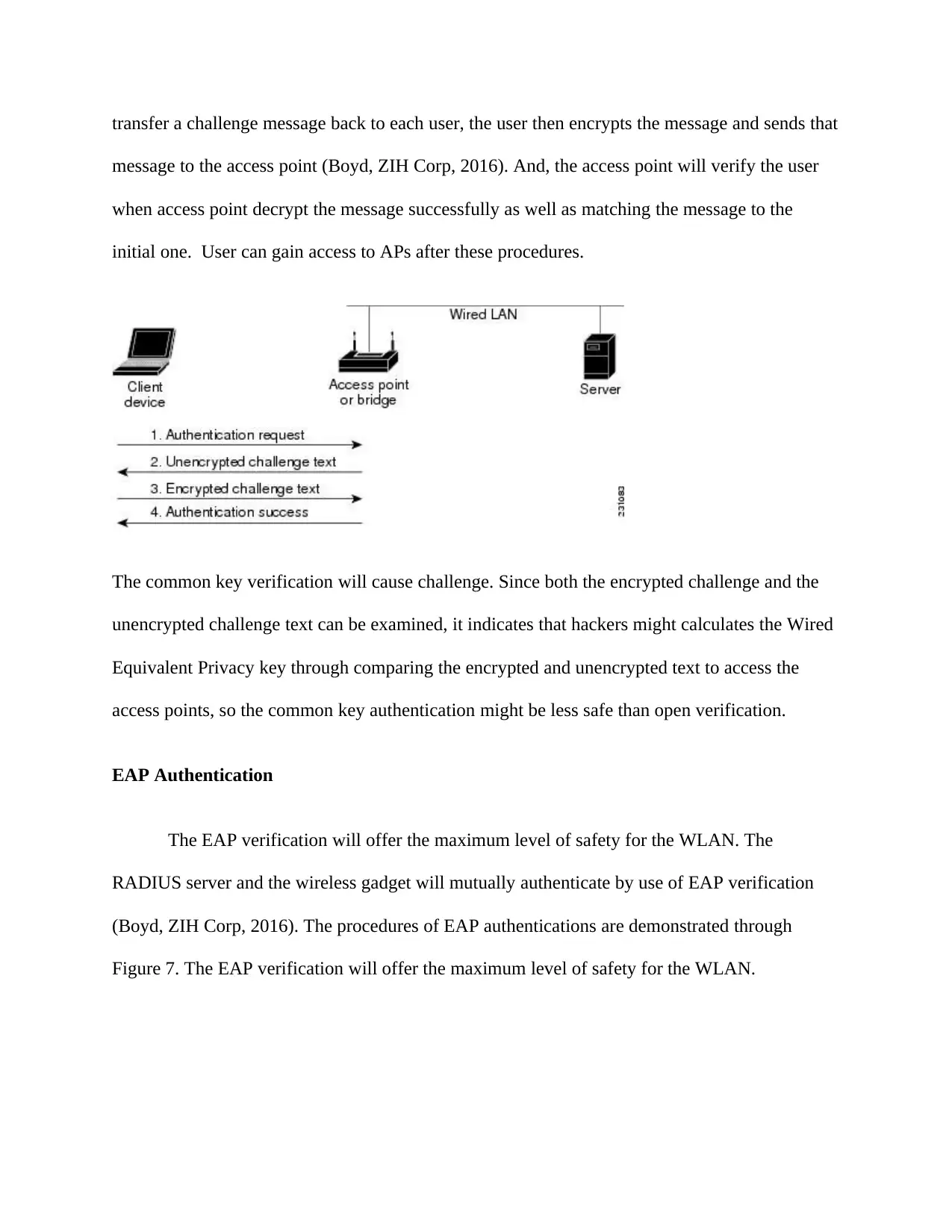
transfer a challenge message back to each user, the user then encrypts the message and sends that
message to the access point (Boyd, ZIH Corp, 2016). And, the access point will verify the user
when access point decrypt the message successfully as well as matching the message to the
initial one. User can gain access to APs after these procedures.
The common key verification will cause challenge. Since both the encrypted challenge and the
unencrypted challenge text can be examined, it indicates that hackers might calculates the Wired
Equivalent Privacy key through comparing the encrypted and unencrypted text to access the
access points, so the common key authentication might be less safe than open verification.
EAP Authentication
The EAP verification will offer the maximum level of safety for the WLAN. The
RADIUS server and the wireless gadget will mutually authenticate by use of EAP verification
(Boyd, ZIH Corp, 2016). The procedures of EAP authentications are demonstrated through
Figure 7. The EAP verification will offer the maximum level of safety for the WLAN.
message to the access point (Boyd, ZIH Corp, 2016). And, the access point will verify the user
when access point decrypt the message successfully as well as matching the message to the
initial one. User can gain access to APs after these procedures.
The common key verification will cause challenge. Since both the encrypted challenge and the
unencrypted challenge text can be examined, it indicates that hackers might calculates the Wired
Equivalent Privacy key through comparing the encrypted and unencrypted text to access the
access points, so the common key authentication might be less safe than open verification.
EAP Authentication
The EAP verification will offer the maximum level of safety for the WLAN. The
RADIUS server and the wireless gadget will mutually authenticate by use of EAP verification
(Boyd, ZIH Corp, 2016). The procedures of EAP authentications are demonstrated through
Figure 7. The EAP verification will offer the maximum level of safety for the WLAN.
Paraphrase This Document
Need a fresh take? Get an instant paraphrase of this document with our AI Paraphraser
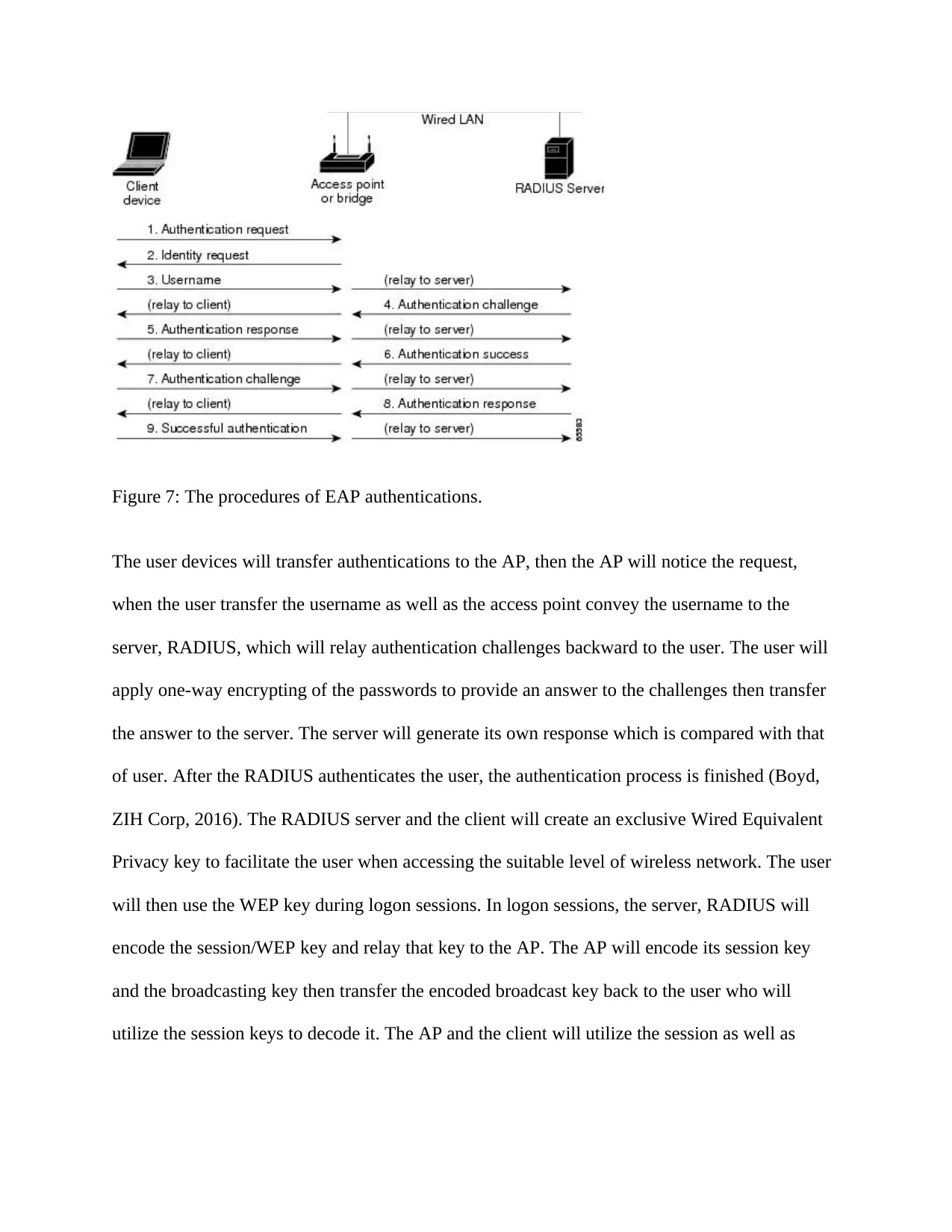
Figure 7: The procedures of EAP authentications.
The user devices will transfer authentications to the AP, then the AP will notice the request,
when the user transfer the username as well as the access point convey the username to the
server, RADIUS, which will relay authentication challenges backward to the user. The user will
apply one-way encrypting of the passwords to provide an answer to the challenges then transfer
the answer to the server. The server will generate its own response which is compared with that
of user. After the RADIUS authenticates the user, the authentication process is finished (Boyd,
ZIH Corp, 2016). The RADIUS server and the client will create an exclusive Wired Equivalent
Privacy key to facilitate the user when accessing the suitable level of wireless network. The user
will then use the WEP key during logon sessions. In logon sessions, the server, RADIUS will
encode the session/WEP key and relay that key to the AP. The AP will encode its session key
and the broadcasting key then transfer the encoded broadcast key back to the user who will
utilize the session keys to decode it. The AP and the client will utilize the session as well as
The user devices will transfer authentications to the AP, then the AP will notice the request,
when the user transfer the username as well as the access point convey the username to the
server, RADIUS, which will relay authentication challenges backward to the user. The user will
apply one-way encrypting of the passwords to provide an answer to the challenges then transfer
the answer to the server. The server will generate its own response which is compared with that
of user. After the RADIUS authenticates the user, the authentication process is finished (Boyd,
ZIH Corp, 2016). The RADIUS server and the client will create an exclusive Wired Equivalent
Privacy key to facilitate the user when accessing the suitable level of wireless network. The user
will then use the WEP key during logon sessions. In logon sessions, the server, RADIUS will
encode the session/WEP key and relay that key to the AP. The AP will encode its session key
and the broadcasting key then transfer the encoded broadcast key back to the user who will
utilize the session keys to decode it. The AP and the client will utilize the session as well as
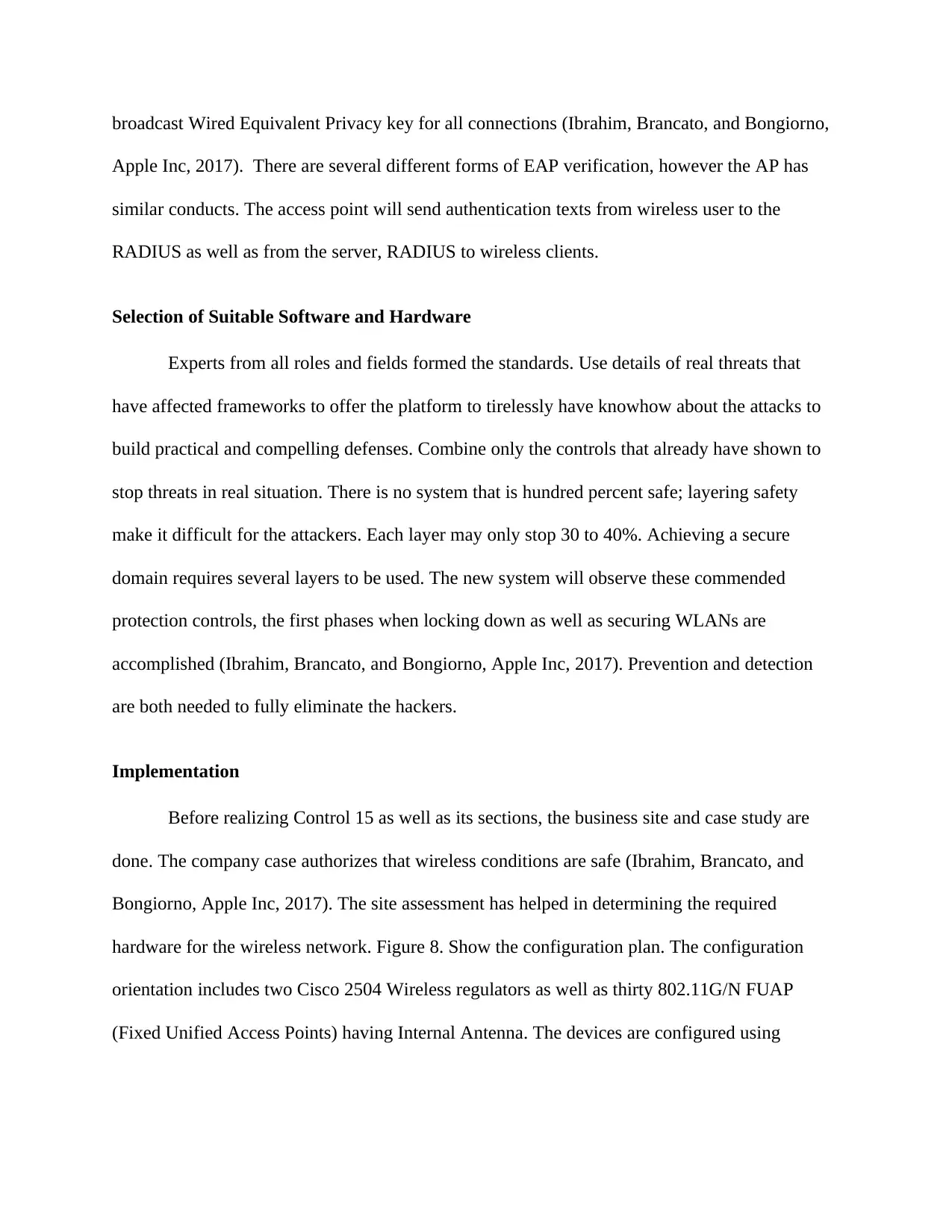
broadcast Wired Equivalent Privacy key for all connections (Ibrahim, Brancato, and Bongiorno,
Apple Inc, 2017). There are several different forms of EAP verification, however the AP has
similar conducts. The access point will send authentication texts from wireless user to the
RADIUS as well as from the server, RADIUS to wireless clients.
Selection of Suitable Software and Hardware
Experts from all roles and fields formed the standards. Use details of real threats that
have affected frameworks to offer the platform to tirelessly have knowhow about the attacks to
build practical and compelling defenses. Combine only the controls that already have shown to
stop threats in real situation. There is no system that is hundred percent safe; layering safety
make it difficult for the attackers. Each layer may only stop 30 to 40%. Achieving a secure
domain requires several layers to be used. The new system will observe these commended
protection controls, the first phases when locking down as well as securing WLANs are
accomplished (Ibrahim, Brancato, and Bongiorno, Apple Inc, 2017). Prevention and detection
are both needed to fully eliminate the hackers.
Implementation
Before realizing Control 15 as well as its sections, the business site and case study are
done. The company case authorizes that wireless conditions are safe (Ibrahim, Brancato, and
Bongiorno, Apple Inc, 2017). The site assessment has helped in determining the required
hardware for the wireless network. Figure 8. Show the configuration plan. The configuration
orientation includes two Cisco 2504 Wireless regulators as well as thirty 802.11G/N FUAP
(Fixed Unified Access Points) having Internal Antenna. The devices are configured using
Apple Inc, 2017). There are several different forms of EAP verification, however the AP has
similar conducts. The access point will send authentication texts from wireless user to the
RADIUS as well as from the server, RADIUS to wireless clients.
Selection of Suitable Software and Hardware
Experts from all roles and fields formed the standards. Use details of real threats that
have affected frameworks to offer the platform to tirelessly have knowhow about the attacks to
build practical and compelling defenses. Combine only the controls that already have shown to
stop threats in real situation. There is no system that is hundred percent safe; layering safety
make it difficult for the attackers. Each layer may only stop 30 to 40%. Achieving a secure
domain requires several layers to be used. The new system will observe these commended
protection controls, the first phases when locking down as well as securing WLANs are
accomplished (Ibrahim, Brancato, and Bongiorno, Apple Inc, 2017). Prevention and detection
are both needed to fully eliminate the hackers.
Implementation
Before realizing Control 15 as well as its sections, the business site and case study are
done. The company case authorizes that wireless conditions are safe (Ibrahim, Brancato, and
Bongiorno, Apple Inc, 2017). The site assessment has helped in determining the required
hardware for the wireless network. Figure 8. Show the configuration plan. The configuration
orientation includes two Cisco 2504 Wireless regulators as well as thirty 802.11G/N FUAP
(Fixed Unified Access Points) having Internal Antenna. The devices are configured using
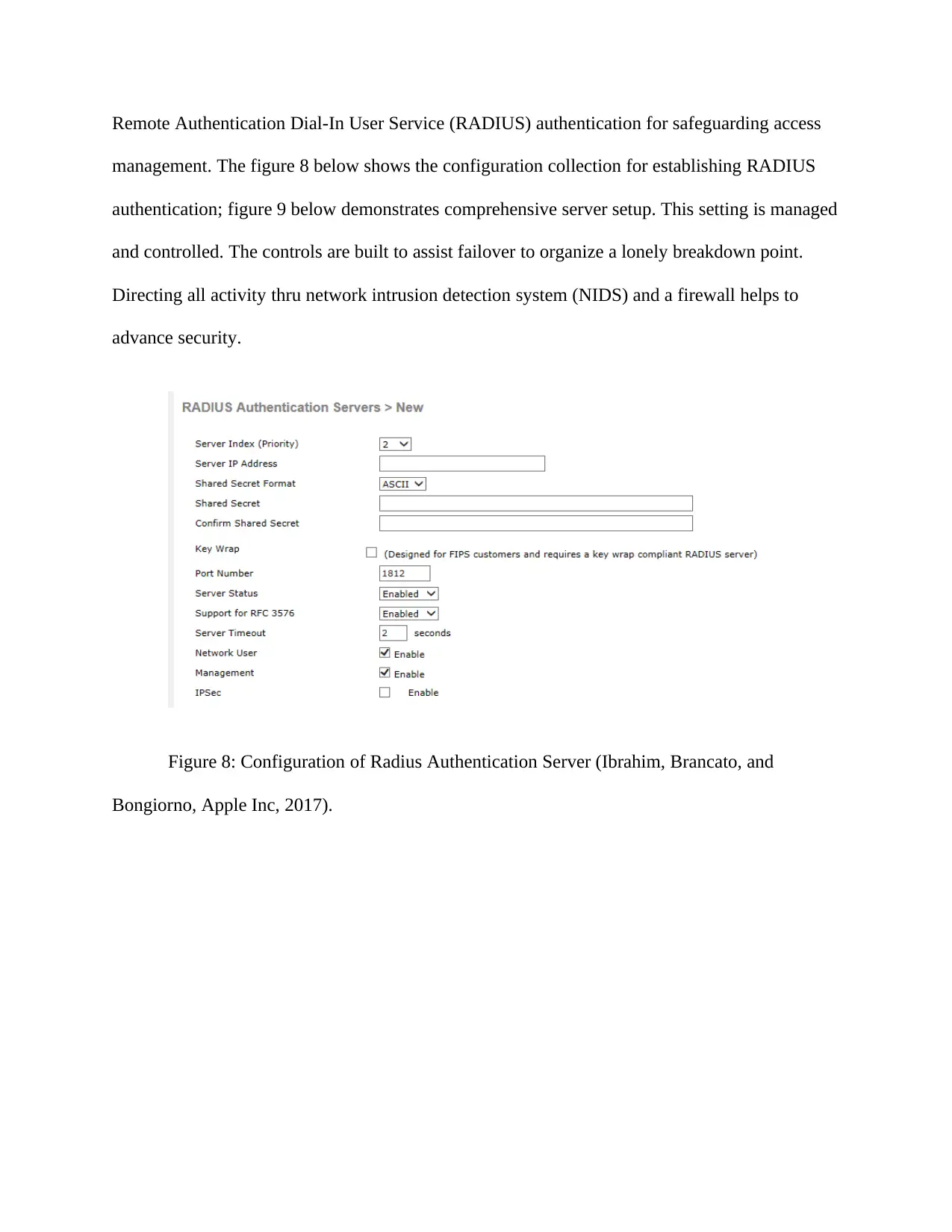
Remote Authentication Dial-In User Service (RADIUS) authentication for safeguarding access
management. The figure 8 below shows the configuration collection for establishing RADIUS
authentication; figure 9 below demonstrates comprehensive server setup. This setting is managed
and controlled. The controls are built to assist failover to organize a lonely breakdown point.
Directing all activity thru network intrusion detection system (NIDS) and a firewall helps to
advance security.
Figure 8: Configuration of Radius Authentication Server (Ibrahim, Brancato, and
Bongiorno, Apple Inc, 2017).
management. The figure 8 below shows the configuration collection for establishing RADIUS
authentication; figure 9 below demonstrates comprehensive server setup. This setting is managed
and controlled. The controls are built to assist failover to organize a lonely breakdown point.
Directing all activity thru network intrusion detection system (NIDS) and a firewall helps to
advance security.
Figure 8: Configuration of Radius Authentication Server (Ibrahim, Brancato, and
Bongiorno, Apple Inc, 2017).
Secure Best Marks with AI Grader
Need help grading? Try our AI Grader for instant feedback on your assignments.
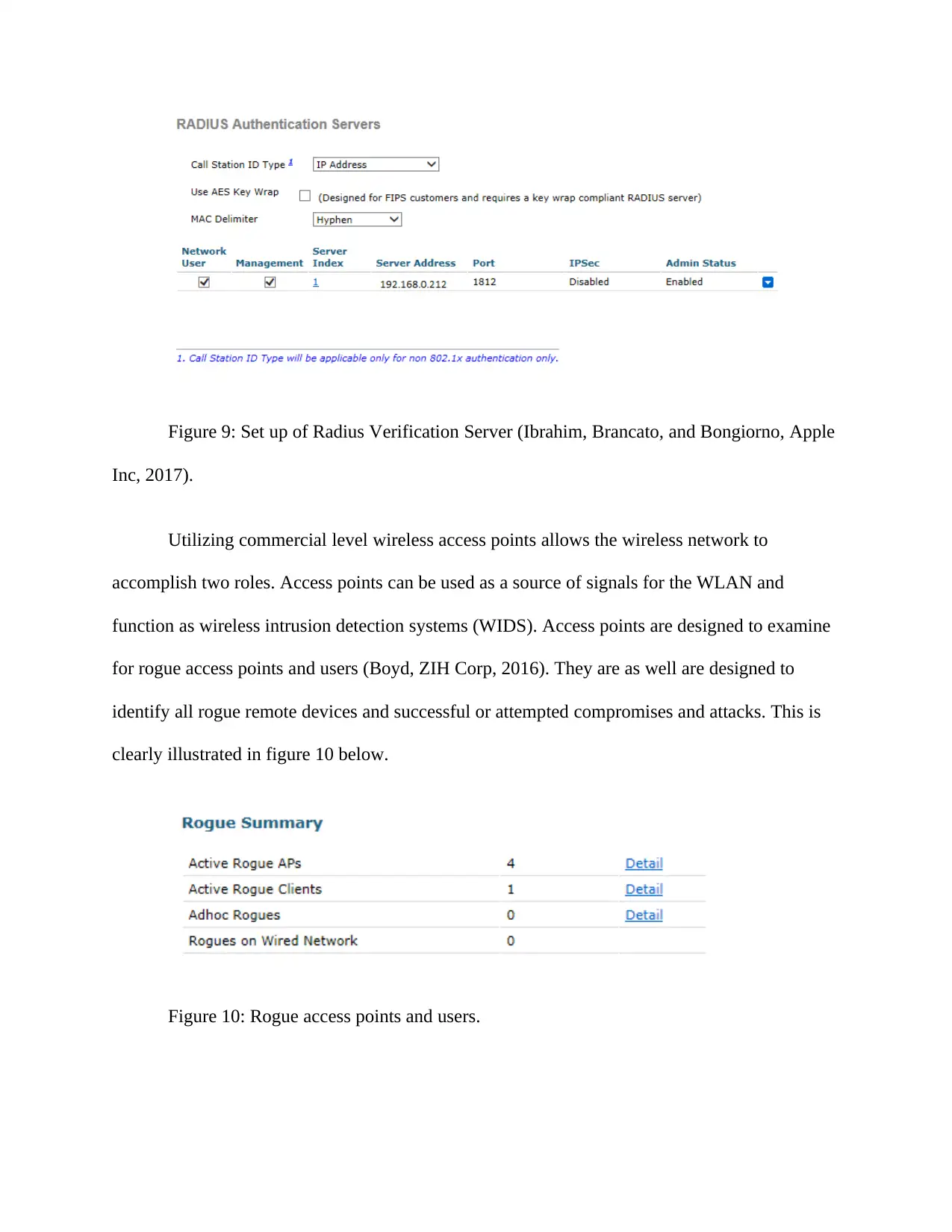
Figure 9: Set up of Radius Verification Server (Ibrahim, Brancato, and Bongiorno, Apple
Inc, 2017).
Utilizing commercial level wireless access points allows the wireless network to
accomplish two roles. Access points can be used as a source of signals for the WLAN and
function as wireless intrusion detection systems (WIDS). Access points are designed to examine
for rogue access points and users (Boyd, ZIH Corp, 2016). They are as well are designed to
identify all rogue remote devices and successful or attempted compromises and attacks. This is
clearly illustrated in figure 10 below.
Figure 10: Rogue access points and users.
Inc, 2017).
Utilizing commercial level wireless access points allows the wireless network to
accomplish two roles. Access points can be used as a source of signals for the WLAN and
function as wireless intrusion detection systems (WIDS). Access points are designed to examine
for rogue access points and users (Boyd, ZIH Corp, 2016). They are as well are designed to
identify all rogue remote devices and successful or attempted compromises and attacks. This is
clearly illustrated in figure 10 below.
Figure 10: Rogue access points and users.
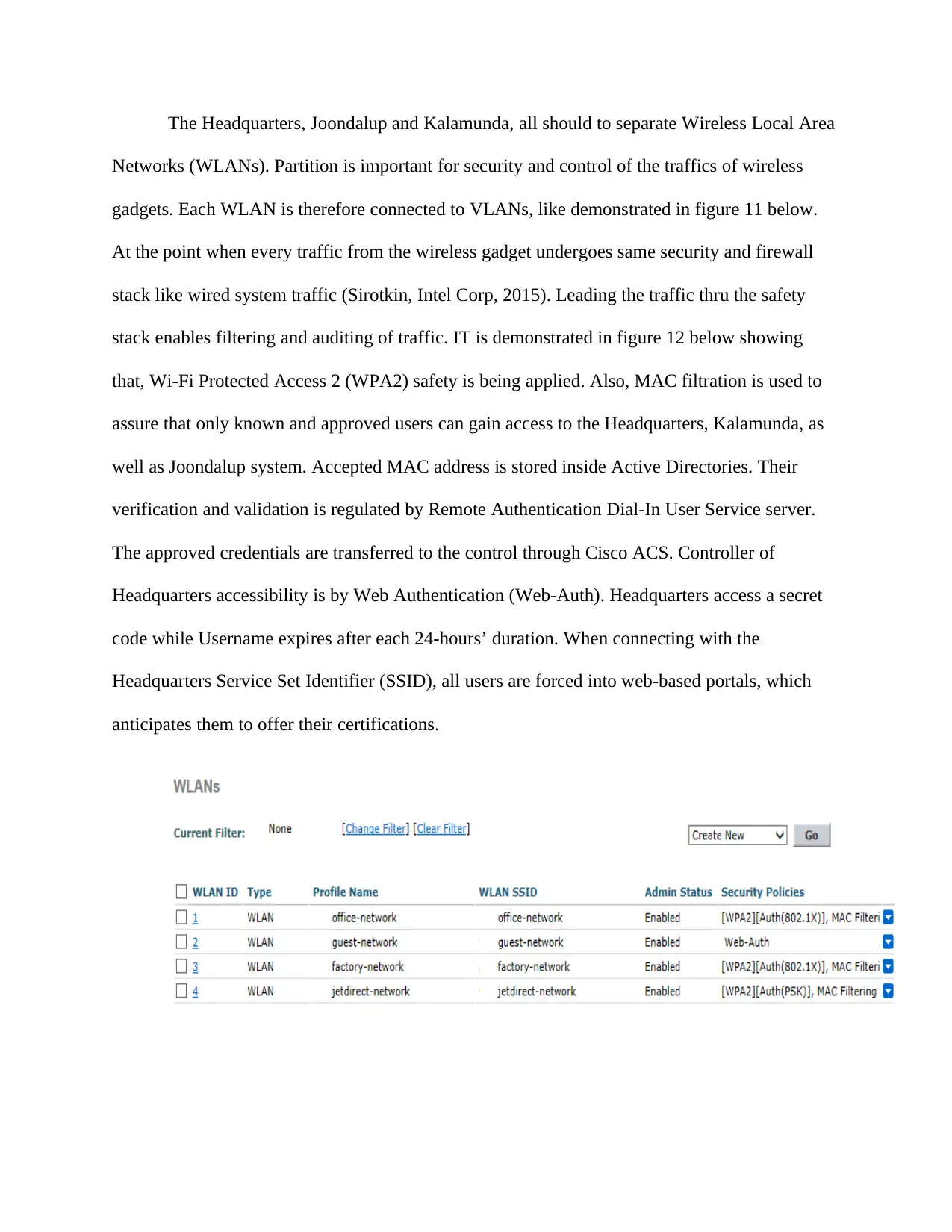
The Headquarters, Joondalup and Kalamunda, all should to separate Wireless Local Area
Networks (WLANs). Partition is important for security and control of the traffics of wireless
gadgets. Each WLAN is therefore connected to VLANs, like demonstrated in figure 11 below.
At the point when every traffic from the wireless gadget undergoes same security and firewall
stack like wired system traffic (Sirotkin, Intel Corp, 2015). Leading the traffic thru the safety
stack enables filtering and auditing of traffic. IT is demonstrated in figure 12 below showing
that, Wi-Fi Protected Access 2 (WPA2) safety is being applied. Also, MAC filtration is used to
assure that only known and approved users can gain access to the Headquarters, Kalamunda, as
well as Joondalup system. Accepted MAC address is stored inside Active Directories. Their
verification and validation is regulated by Remote Authentication Dial-In User Service server.
The approved credentials are transferred to the control through Cisco ACS. Controller of
Headquarters accessibility is by Web Authentication (Web-Auth). Headquarters access a secret
code while Username expires after each 24-hours’ duration. When connecting with the
Headquarters Service Set Identifier (SSID), all users are forced into web-based portals, which
anticipates them to offer their certifications.
Networks (WLANs). Partition is important for security and control of the traffics of wireless
gadgets. Each WLAN is therefore connected to VLANs, like demonstrated in figure 11 below.
At the point when every traffic from the wireless gadget undergoes same security and firewall
stack like wired system traffic (Sirotkin, Intel Corp, 2015). Leading the traffic thru the safety
stack enables filtering and auditing of traffic. IT is demonstrated in figure 12 below showing
that, Wi-Fi Protected Access 2 (WPA2) safety is being applied. Also, MAC filtration is used to
assure that only known and approved users can gain access to the Headquarters, Kalamunda, as
well as Joondalup system. Accepted MAC address is stored inside Active Directories. Their
verification and validation is regulated by Remote Authentication Dial-In User Service server.
The approved credentials are transferred to the control through Cisco ACS. Controller of
Headquarters accessibility is by Web Authentication (Web-Auth). Headquarters access a secret
code while Username expires after each 24-hours’ duration. When connecting with the
Headquarters Service Set Identifier (SSID), all users are forced into web-based portals, which
anticipates them to offer their certifications.
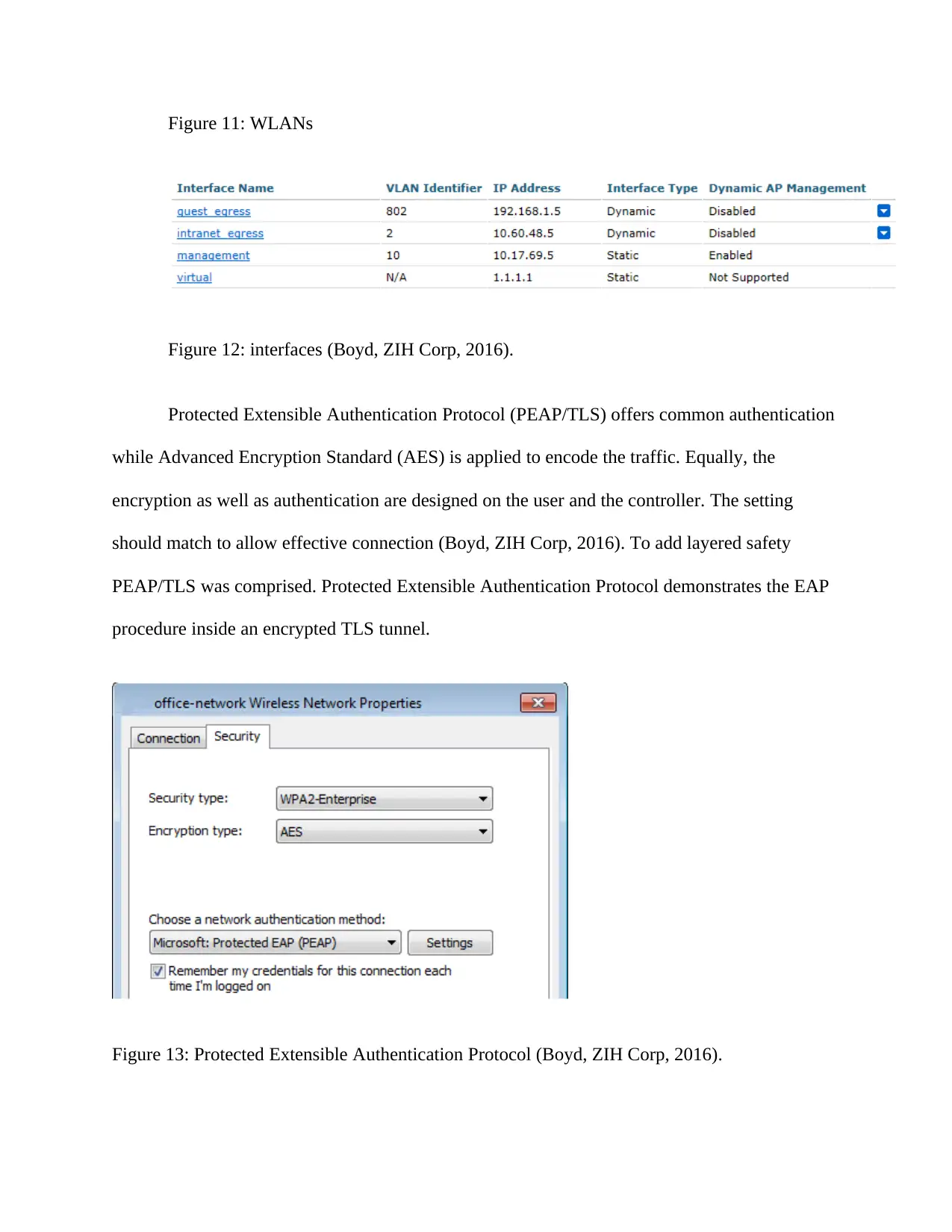
Figure 11: WLANs
Figure 12: interfaces (Boyd, ZIH Corp, 2016).
Protected Extensible Authentication Protocol (PEAP/TLS) offers common authentication
while Advanced Encryption Standard (AES) is applied to encode the traffic. Equally, the
encryption as well as authentication are designed on the user and the controller. The setting
should match to allow effective connection (Boyd, ZIH Corp, 2016). To add layered safety
PEAP/TLS was comprised. Protected Extensible Authentication Protocol demonstrates the EAP
procedure inside an encrypted TLS tunnel.
Figure 13: Protected Extensible Authentication Protocol (Boyd, ZIH Corp, 2016).
Figure 12: interfaces (Boyd, ZIH Corp, 2016).
Protected Extensible Authentication Protocol (PEAP/TLS) offers common authentication
while Advanced Encryption Standard (AES) is applied to encode the traffic. Equally, the
encryption as well as authentication are designed on the user and the controller. The setting
should match to allow effective connection (Boyd, ZIH Corp, 2016). To add layered safety
PEAP/TLS was comprised. Protected Extensible Authentication Protocol demonstrates the EAP
procedure inside an encrypted TLS tunnel.
Figure 13: Protected Extensible Authentication Protocol (Boyd, ZIH Corp, 2016).
Paraphrase This Document
Need a fresh take? Get an instant paraphrase of this document with our AI Paraphraser
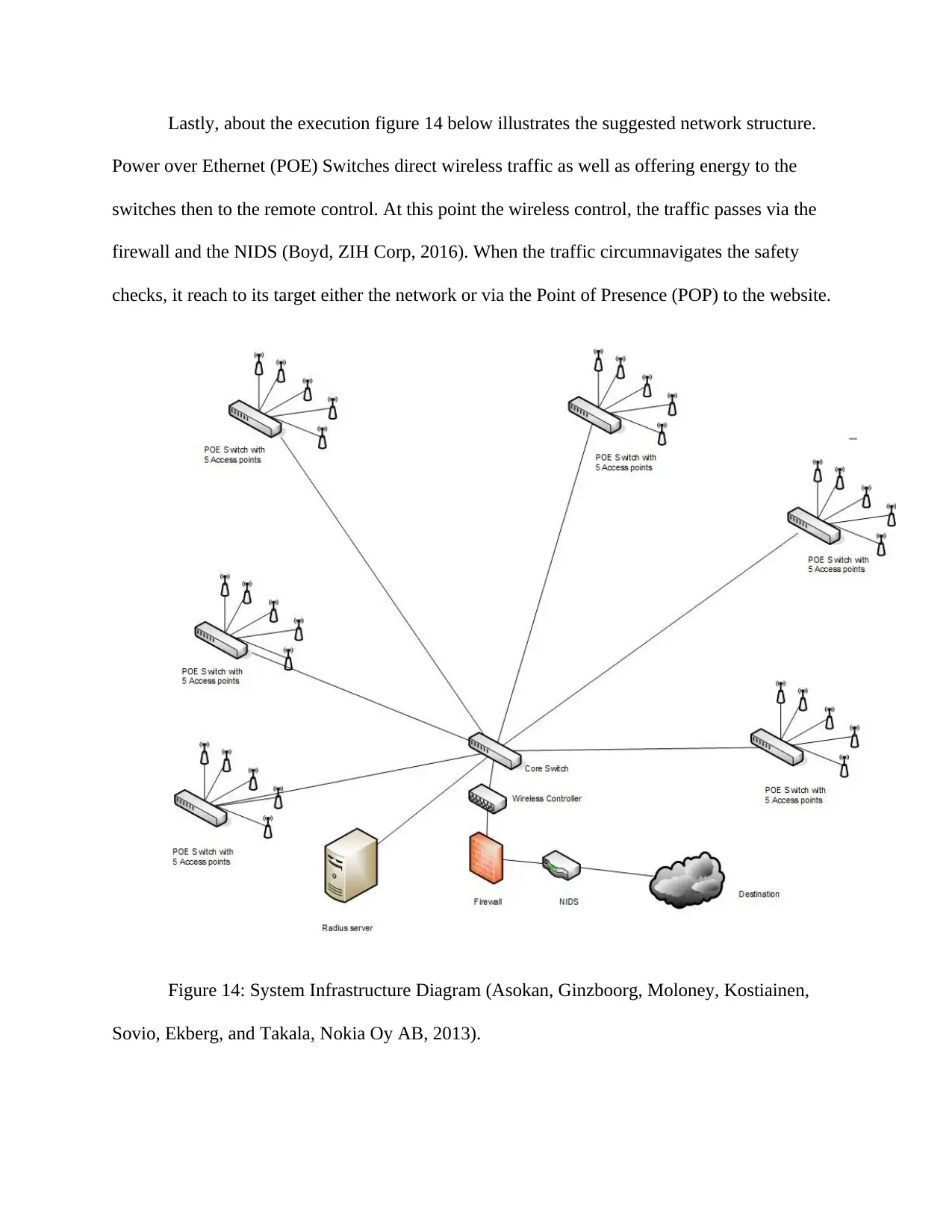
Lastly, about the execution figure 14 below illustrates the suggested network structure.
Power over Ethernet (POE) Switches direct wireless traffic as well as offering energy to the
switches then to the remote control. At this point the wireless control, the traffic passes via the
firewall and the NIDS (Boyd, ZIH Corp, 2016). When the traffic circumnavigates the safety
checks, it reach to its target either the network or via the Point of Presence (POP) to the website.
Figure 14: System Infrastructure Diagram (Asokan, Ginzboorg, Moloney, Kostiainen,
Sovio, Ekberg, and Takala, Nokia Oy AB, 2013).
Power over Ethernet (POE) Switches direct wireless traffic as well as offering energy to the
switches then to the remote control. At this point the wireless control, the traffic passes via the
firewall and the NIDS (Boyd, ZIH Corp, 2016). When the traffic circumnavigates the safety
checks, it reach to its target either the network or via the Point of Presence (POP) to the website.
Figure 14: System Infrastructure Diagram (Asokan, Ginzboorg, Moloney, Kostiainen,
Sovio, Ekberg, and Takala, Nokia Oy AB, 2013).
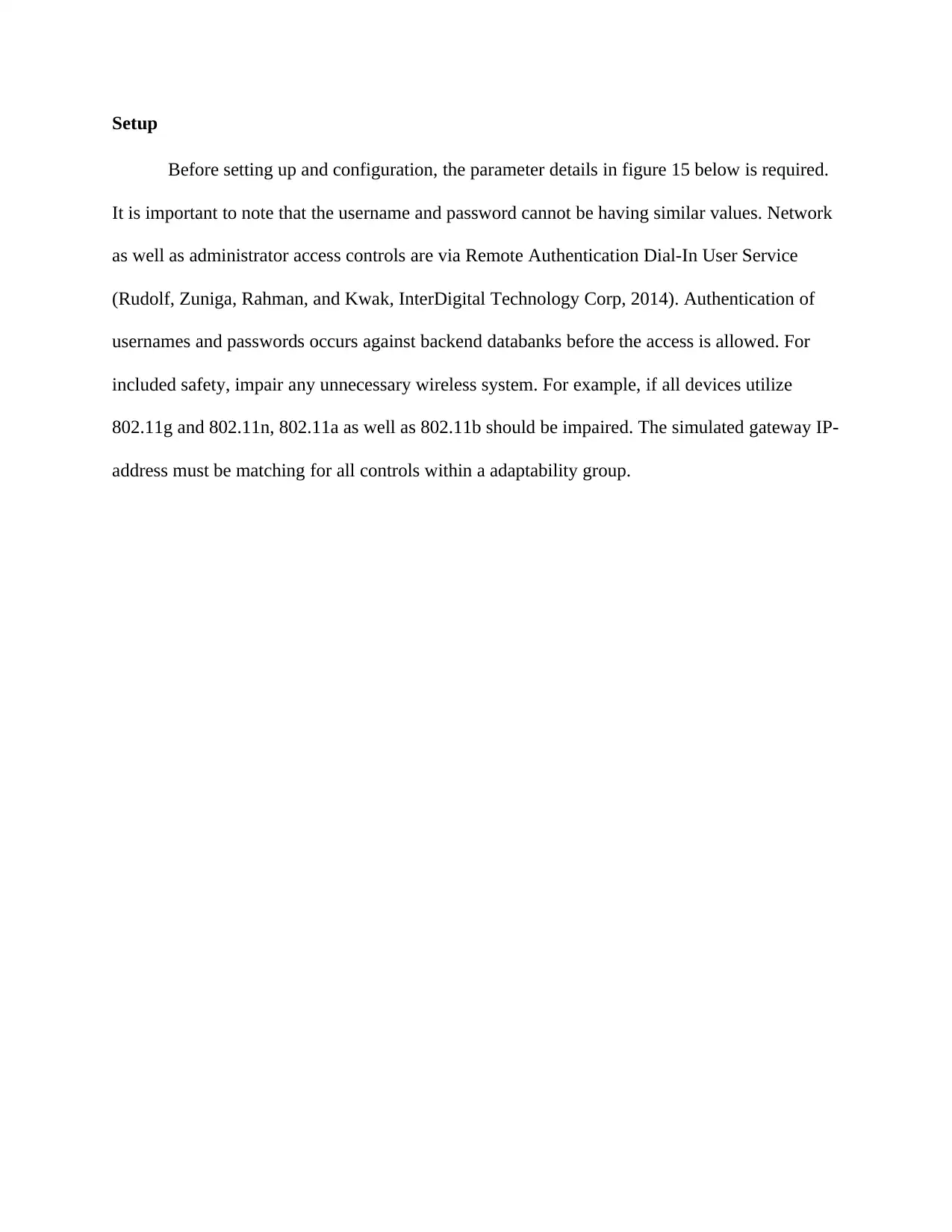
Setup
Before setting up and configuration, the parameter details in figure 15 below is required.
It is important to note that the username and password cannot be having similar values. Network
as well as administrator access controls are via Remote Authentication Dial-In User Service
(Rudolf, Zuniga, Rahman, and Kwak, InterDigital Technology Corp, 2014). Authentication of
usernames and passwords occurs against backend databanks before the access is allowed. For
included safety, impair any unnecessary wireless system. For example, if all devices utilize
802.11g and 802.11n, 802.11a as well as 802.11b should be impaired. The simulated gateway IP-
address must be matching for all controls within a adaptability group.
Before setting up and configuration, the parameter details in figure 15 below is required.
It is important to note that the username and password cannot be having similar values. Network
as well as administrator access controls are via Remote Authentication Dial-In User Service
(Rudolf, Zuniga, Rahman, and Kwak, InterDigital Technology Corp, 2014). Authentication of
usernames and passwords occurs against backend databanks before the access is allowed. For
included safety, impair any unnecessary wireless system. For example, if all devices utilize
802.11g and 802.11n, 802.11a as well as 802.11b should be impaired. The simulated gateway IP-
address must be matching for all controls within a adaptability group.
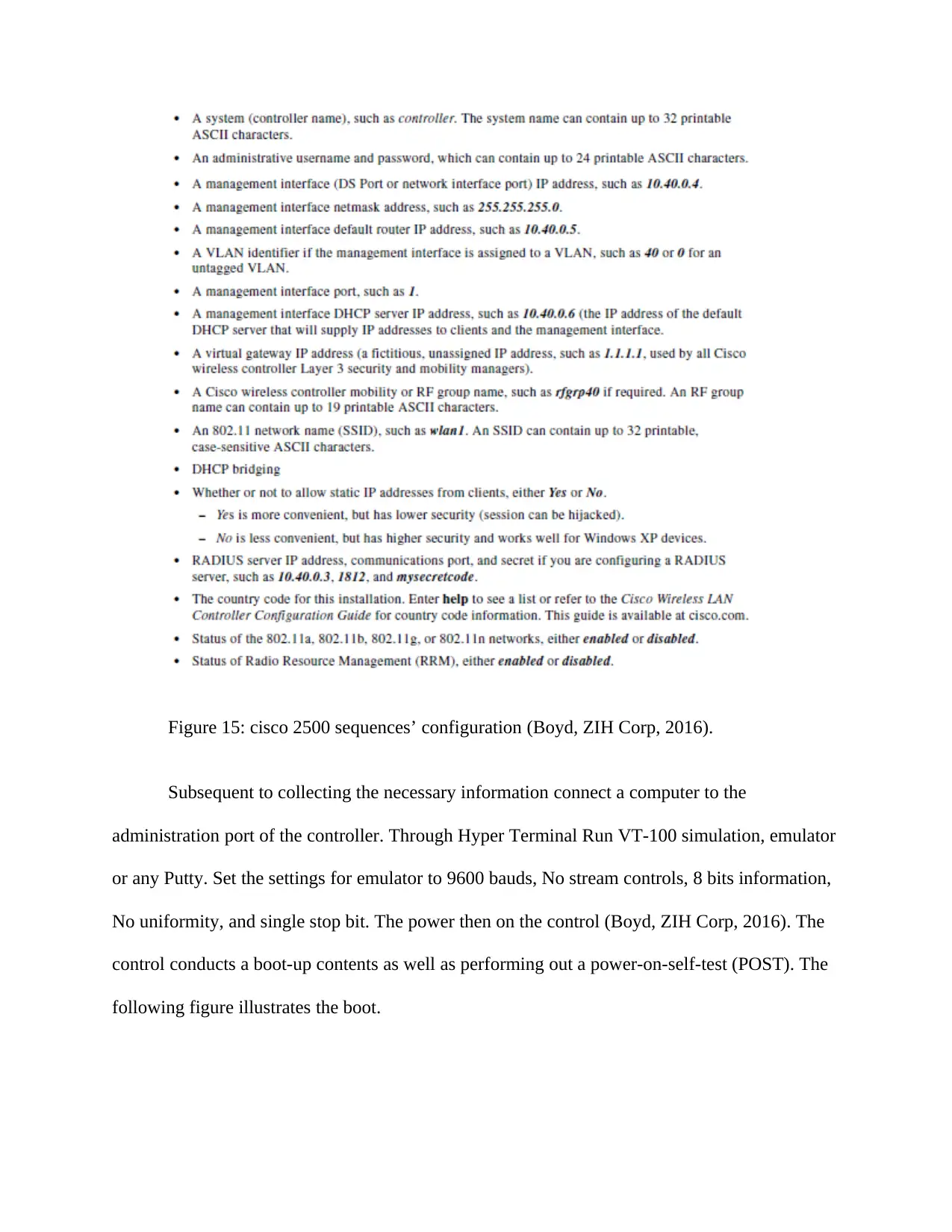
Figure 15: cisco 2500 sequences’ configuration (Boyd, ZIH Corp, 2016).
Subsequent to collecting the necessary information connect a computer to the
administration port of the controller. Through Hyper Terminal Run VT-100 simulation, emulator
or any Putty. Set the settings for emulator to 9600 bauds, No stream controls, 8 bits information,
No uniformity, and single stop bit. The power then on the control (Boyd, ZIH Corp, 2016). The
control conducts a boot-up contents as well as performing out a power-on-self-test (POST). The
following figure illustrates the boot.
Subsequent to collecting the necessary information connect a computer to the
administration port of the controller. Through Hyper Terminal Run VT-100 simulation, emulator
or any Putty. Set the settings for emulator to 9600 bauds, No stream controls, 8 bits information,
No uniformity, and single stop bit. The power then on the control (Boyd, ZIH Corp, 2016). The
control conducts a boot-up contents as well as performing out a power-on-self-test (POST). The
following figure illustrates the boot.
Secure Best Marks with AI Grader
Need help grading? Try our AI Grader for instant feedback on your assignments.
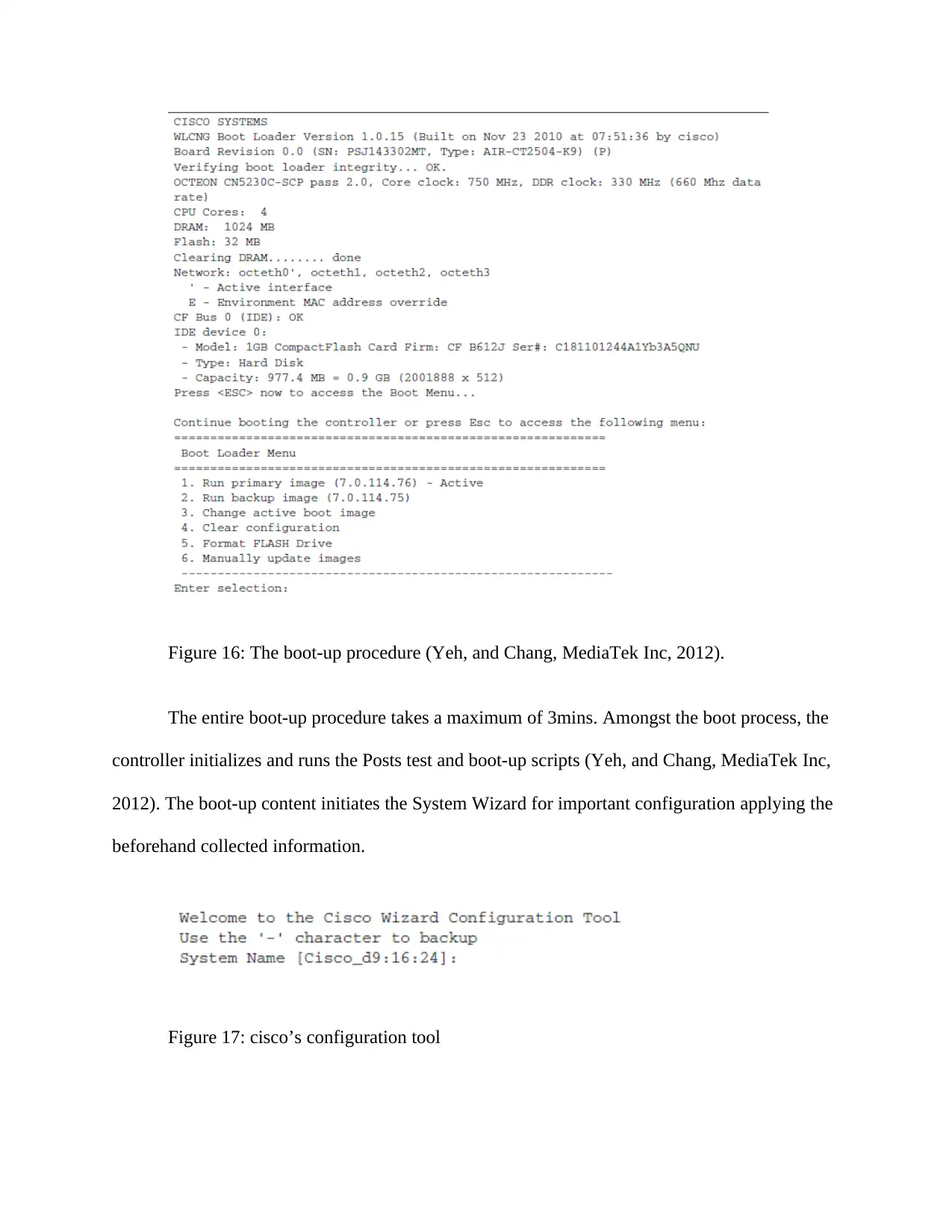
Figure 16: The boot-up procedure (Yeh, and Chang, MediaTek Inc, 2012).
The entire boot-up procedure takes a maximum of 3mins. Amongst the boot process, the
controller initializes and runs the Posts test and boot-up scripts (Yeh, and Chang, MediaTek Inc,
2012). The boot-up content initiates the System Wizard for important configuration applying the
beforehand collected information.
Figure 17: cisco’s configuration tool
The entire boot-up procedure takes a maximum of 3mins. Amongst the boot process, the
controller initializes and runs the Posts test and boot-up scripts (Yeh, and Chang, MediaTek Inc,
2012). The boot-up content initiates the System Wizard for important configuration applying the
beforehand collected information.
Figure 17: cisco’s configuration tool
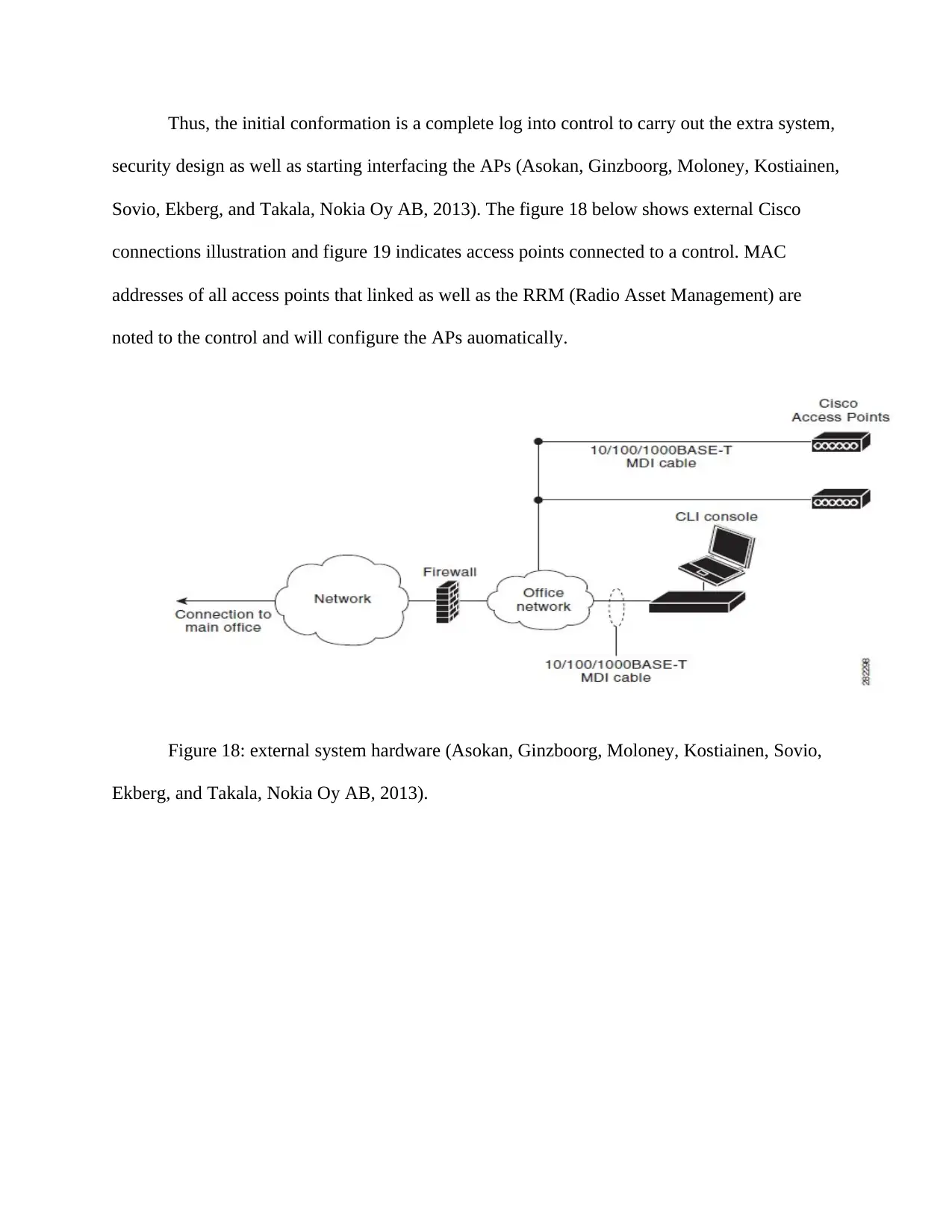
Thus, the initial conformation is a complete log into control to carry out the extra system,
security design as well as starting interfacing the APs (Asokan, Ginzboorg, Moloney, Kostiainen,
Sovio, Ekberg, and Takala, Nokia Oy AB, 2013). The figure 18 below shows external Cisco
connections illustration and figure 19 indicates access points connected to a control. MAC
addresses of all access points that linked as well as the RRM (Radio Asset Management) are
noted to the control and will configure the APs auomatically.
Figure 18: external system hardware (Asokan, Ginzboorg, Moloney, Kostiainen, Sovio,
Ekberg, and Takala, Nokia Oy AB, 2013).
security design as well as starting interfacing the APs (Asokan, Ginzboorg, Moloney, Kostiainen,
Sovio, Ekberg, and Takala, Nokia Oy AB, 2013). The figure 18 below shows external Cisco
connections illustration and figure 19 indicates access points connected to a control. MAC
addresses of all access points that linked as well as the RRM (Radio Asset Management) are
noted to the control and will configure the APs auomatically.
Figure 18: external system hardware (Asokan, Ginzboorg, Moloney, Kostiainen, Sovio,
Ekberg, and Takala, Nokia Oy AB, 2013).
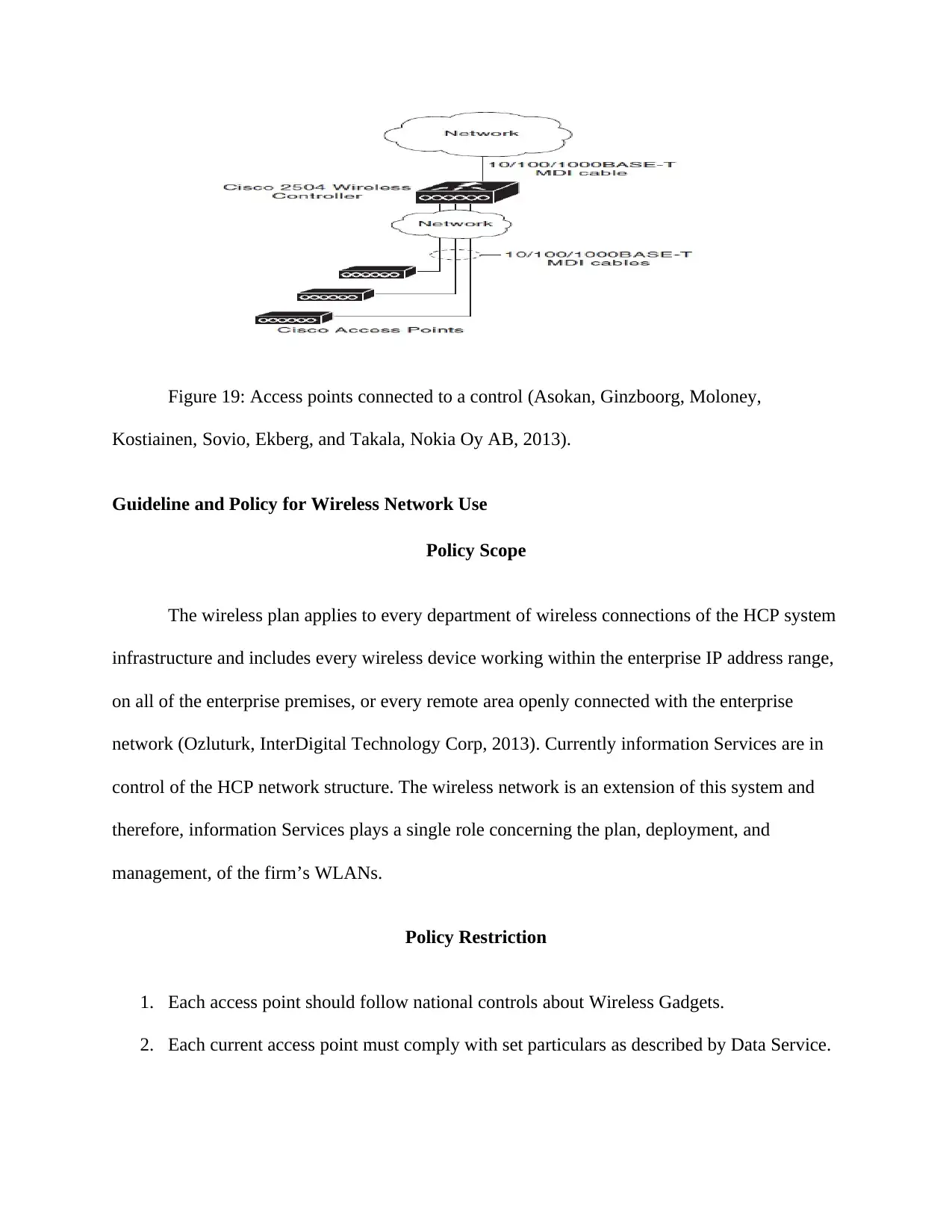
Figure 19: Access points connected to a control (Asokan, Ginzboorg, Moloney,
Kostiainen, Sovio, Ekberg, and Takala, Nokia Oy AB, 2013).
Guideline and Policy for Wireless Network Use
Policy Scope
The wireless plan applies to every department of wireless connections of the HCP system
infrastructure and includes every wireless device working within the enterprise IP address range,
on all of the enterprise premises, or every remote area openly connected with the enterprise
network (Ozluturk, InterDigital Technology Corp, 2013). Currently information Services are in
control of the HCP network structure. The wireless network is an extension of this system and
therefore, information Services plays a single role concerning the plan, deployment, and
management, of the firm’s WLANs.
Policy Restriction
1. Each access point should follow national controls about Wireless Gadgets.
2. Each current access point must comply with set particulars as described by Data Service.
Kostiainen, Sovio, Ekberg, and Takala, Nokia Oy AB, 2013).
Guideline and Policy for Wireless Network Use
Policy Scope
The wireless plan applies to every department of wireless connections of the HCP system
infrastructure and includes every wireless device working within the enterprise IP address range,
on all of the enterprise premises, or every remote area openly connected with the enterprise
network (Ozluturk, InterDigital Technology Corp, 2013). Currently information Services are in
control of the HCP network structure. The wireless network is an extension of this system and
therefore, information Services plays a single role concerning the plan, deployment, and
management, of the firm’s WLANs.
Policy Restriction
1. Each access point should follow national controls about Wireless Gadgets.
2. Each current access point must comply with set particulars as described by Data Service.
Paraphrase This Document
Need a fresh take? Get an instant paraphrase of this document with our AI Paraphraser
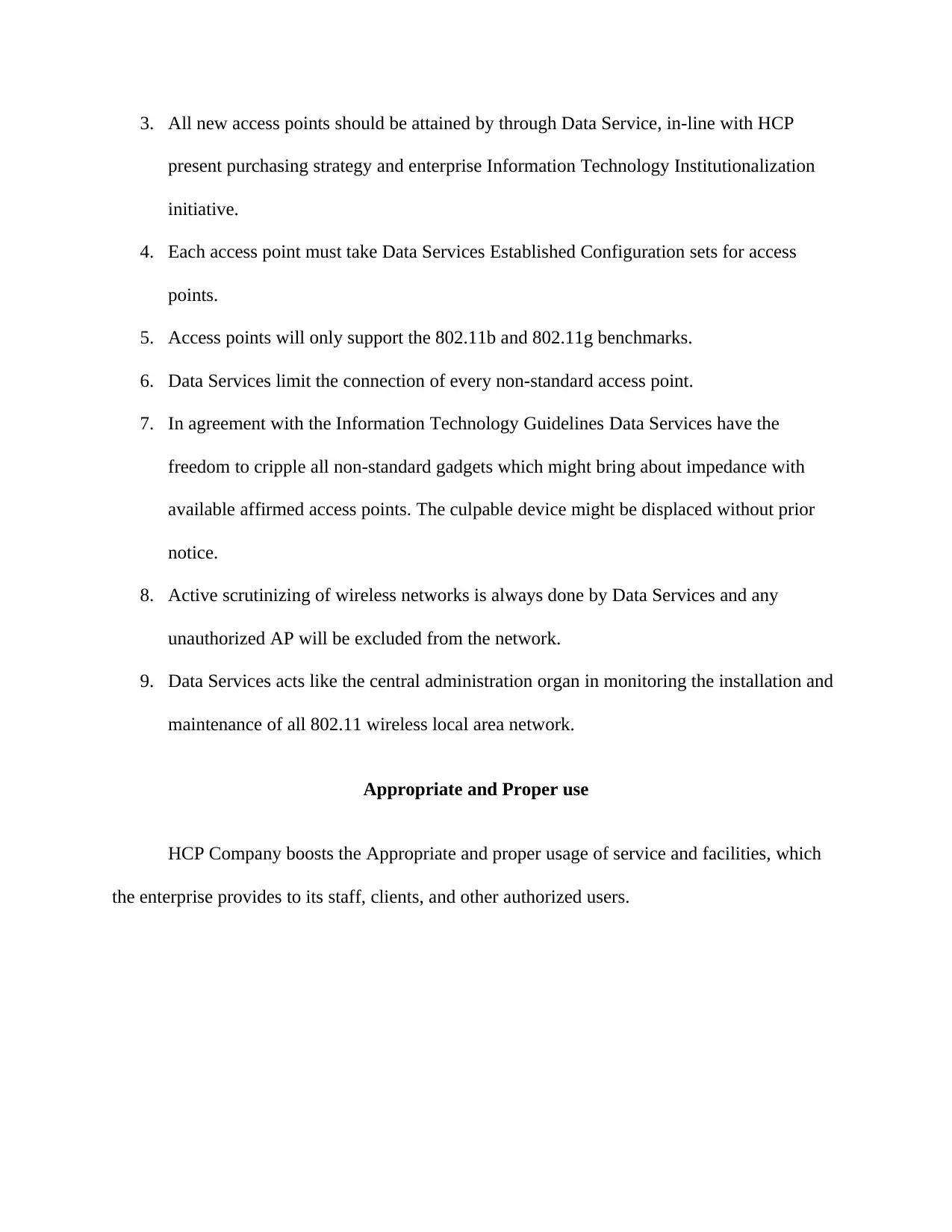
3. All new access points should be attained by through Data Service, in-line with HCP
present purchasing strategy and enterprise Information Technology Institutionalization
initiative.
4. Each access point must take Data Services Established Configuration sets for access
points.
5. Access points will only support the 802.11b and 802.11g benchmarks.
6. Data Services limit the connection of every non-standard access point.
7. In agreement with the Information Technology Guidelines Data Services have the
freedom to cripple all non-standard gadgets which might bring about impedance with
available affirmed access points. The culpable device might be displaced without prior
notice.
8. Active scrutinizing of wireless networks is always done by Data Services and any
unauthorized AP will be excluded from the network.
9. Data Services acts like the central administration organ in monitoring the installation and
maintenance of all 802.11 wireless local area network.
Appropriate and Proper use
HCP Company boosts the Appropriate and proper usage of service and facilities, which
the enterprise provides to its staff, clients, and other authorized users.
present purchasing strategy and enterprise Information Technology Institutionalization
initiative.
4. Each access point must take Data Services Established Configuration sets for access
points.
5. Access points will only support the 802.11b and 802.11g benchmarks.
6. Data Services limit the connection of every non-standard access point.
7. In agreement with the Information Technology Guidelines Data Services have the
freedom to cripple all non-standard gadgets which might bring about impedance with
available affirmed access points. The culpable device might be displaced without prior
notice.
8. Active scrutinizing of wireless networks is always done by Data Services and any
unauthorized AP will be excluded from the network.
9. Data Services acts like the central administration organ in monitoring the installation and
maintenance of all 802.11 wireless local area network.
Appropriate and Proper use
HCP Company boosts the Appropriate and proper usage of service and facilities, which
the enterprise provides to its staff, clients, and other authorized users.
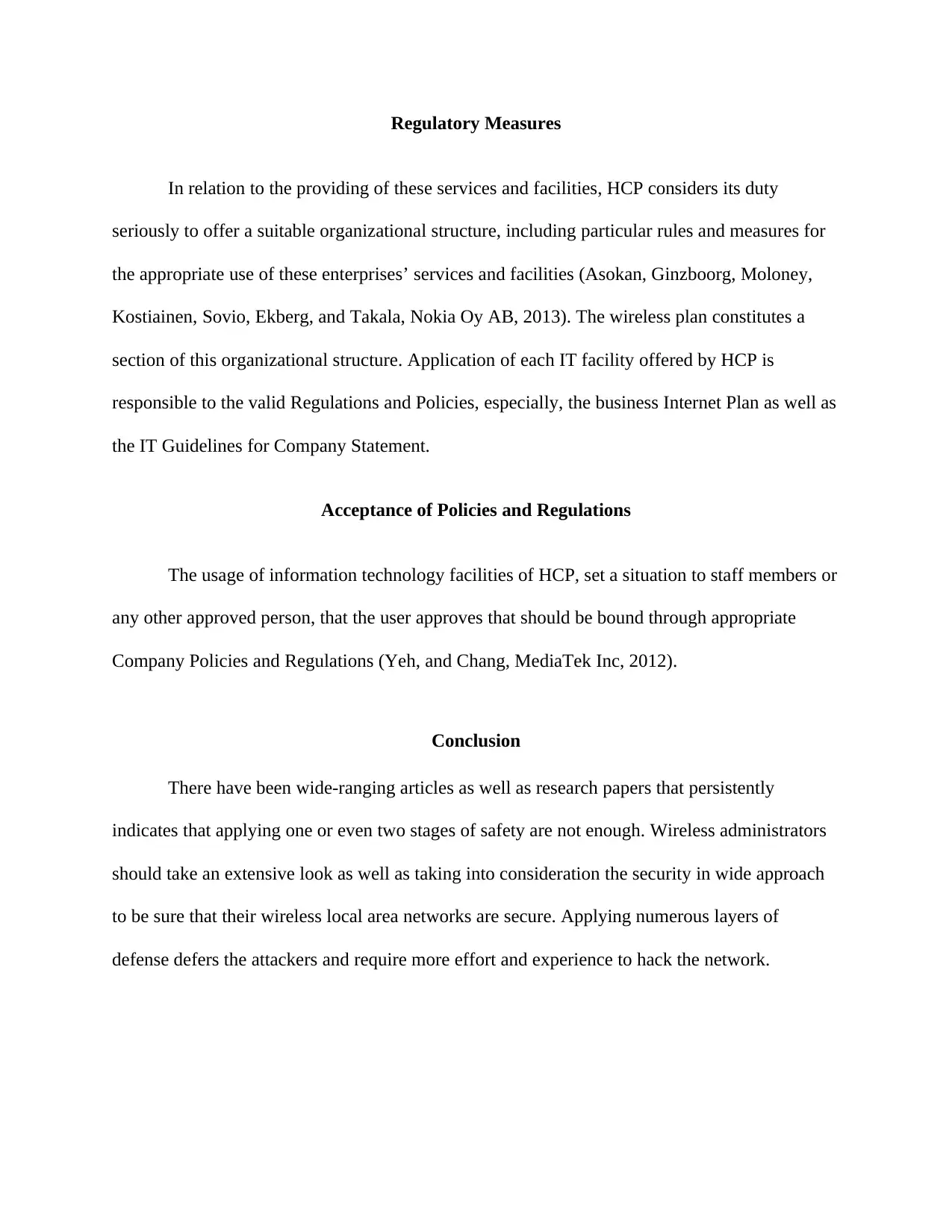
Regulatory Measures
In relation to the providing of these services and facilities, HCP considers its duty
seriously to offer a suitable organizational structure, including particular rules and measures for
the appropriate use of these enterprises’ services and facilities (Asokan, Ginzboorg, Moloney,
Kostiainen, Sovio, Ekberg, and Takala, Nokia Oy AB, 2013). The wireless plan constitutes a
section of this organizational structure. Application of each IT facility offered by HCP is
responsible to the valid Regulations and Policies, especially, the business Internet Plan as well as
the IT Guidelines for Company Statement.
Acceptance of Policies and Regulations
The usage of information technology facilities of HCP, set a situation to staff members or
any other approved person, that the user approves that should be bound through appropriate
Company Policies and Regulations (Yeh, and Chang, MediaTek Inc, 2012).
Conclusion
There have been wide-ranging articles as well as research papers that persistently
indicates that applying one or even two stages of safety are not enough. Wireless administrators
should take an extensive look as well as taking into consideration the security in wide approach
to be sure that their wireless local area networks are secure. Applying numerous layers of
defense defers the attackers and require more effort and experience to hack the network.
In relation to the providing of these services and facilities, HCP considers its duty
seriously to offer a suitable organizational structure, including particular rules and measures for
the appropriate use of these enterprises’ services and facilities (Asokan, Ginzboorg, Moloney,
Kostiainen, Sovio, Ekberg, and Takala, Nokia Oy AB, 2013). The wireless plan constitutes a
section of this organizational structure. Application of each IT facility offered by HCP is
responsible to the valid Regulations and Policies, especially, the business Internet Plan as well as
the IT Guidelines for Company Statement.
Acceptance of Policies and Regulations
The usage of information technology facilities of HCP, set a situation to staff members or
any other approved person, that the user approves that should be bound through appropriate
Company Policies and Regulations (Yeh, and Chang, MediaTek Inc, 2012).
Conclusion
There have been wide-ranging articles as well as research papers that persistently
indicates that applying one or even two stages of safety are not enough. Wireless administrators
should take an extensive look as well as taking into consideration the security in wide approach
to be sure that their wireless local area networks are secure. Applying numerous layers of
defense defers the attackers and require more effort and experience to hack the network.
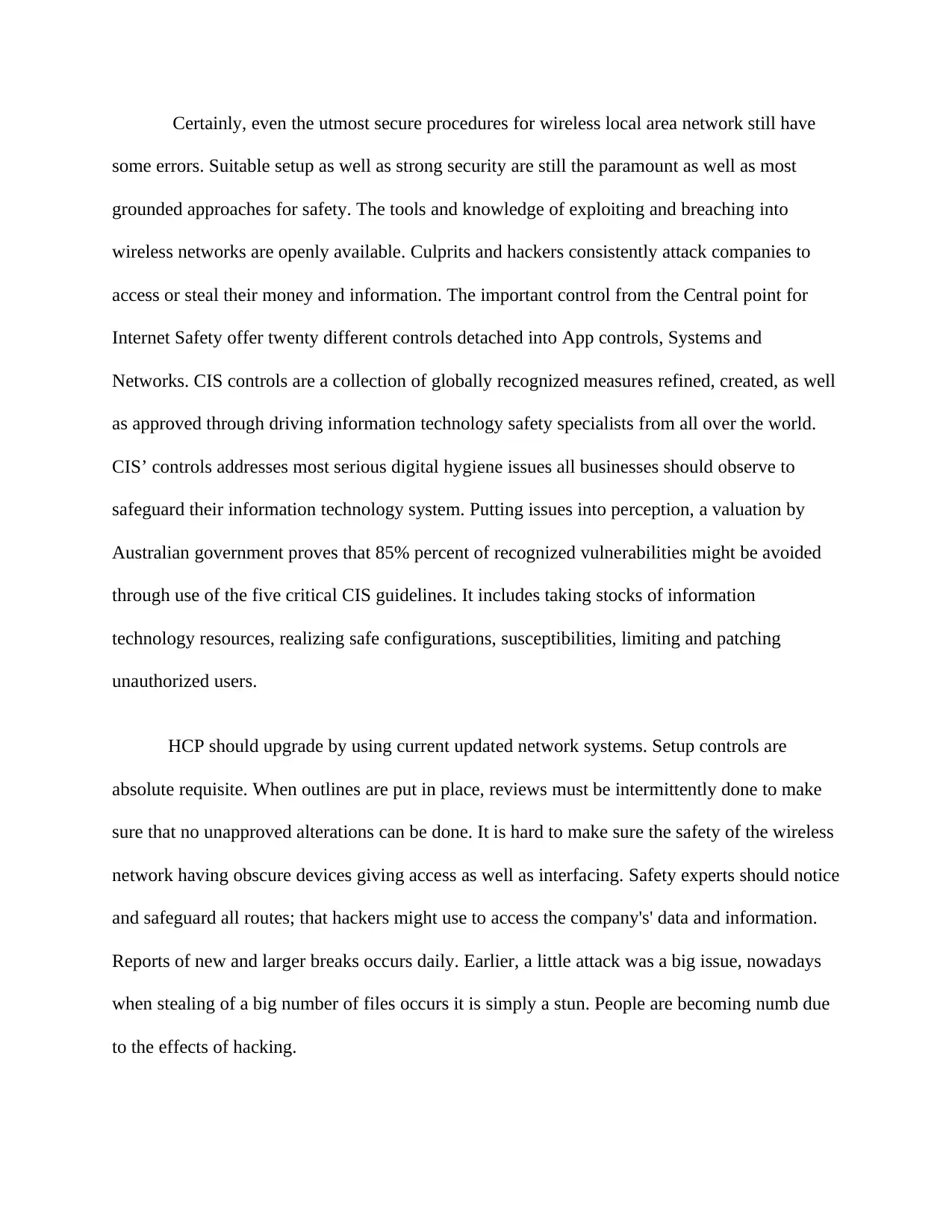
Certainly, even the utmost secure procedures for wireless local area network still have
some errors. Suitable setup as well as strong security are still the paramount as well as most
grounded approaches for safety. The tools and knowledge of exploiting and breaching into
wireless networks are openly available. Culprits and hackers consistently attack companies to
access or steal their money and information. The important control from the Central point for
Internet Safety offer twenty different controls detached into App controls, Systems and
Networks. CIS controls are a collection of globally recognized measures refined, created, as well
as approved through driving information technology safety specialists from all over the world.
CIS’ controls addresses most serious digital hygiene issues all businesses should observe to
safeguard their information technology system. Putting issues into perception, a valuation by
Australian government proves that 85% percent of recognized vulnerabilities might be avoided
through use of the five critical CIS guidelines. It includes taking stocks of information
technology resources, realizing safe configurations, susceptibilities, limiting and patching
unauthorized users.
HCP should upgrade by using current updated network systems. Setup controls are
absolute requisite. When outlines are put in place, reviews must be intermittently done to make
sure that no unapproved alterations can be done. It is hard to make sure the safety of the wireless
network having obscure devices giving access as well as interfacing. Safety experts should notice
and safeguard all routes; that hackers might use to access the company's' data and information.
Reports of new and larger breaks occurs daily. Earlier, a little attack was a big issue, nowadays
when stealing of a big number of files occurs it is simply a stun. People are becoming numb due
to the effects of hacking.
some errors. Suitable setup as well as strong security are still the paramount as well as most
grounded approaches for safety. The tools and knowledge of exploiting and breaching into
wireless networks are openly available. Culprits and hackers consistently attack companies to
access or steal their money and information. The important control from the Central point for
Internet Safety offer twenty different controls detached into App controls, Systems and
Networks. CIS controls are a collection of globally recognized measures refined, created, as well
as approved through driving information technology safety specialists from all over the world.
CIS’ controls addresses most serious digital hygiene issues all businesses should observe to
safeguard their information technology system. Putting issues into perception, a valuation by
Australian government proves that 85% percent of recognized vulnerabilities might be avoided
through use of the five critical CIS guidelines. It includes taking stocks of information
technology resources, realizing safe configurations, susceptibilities, limiting and patching
unauthorized users.
HCP should upgrade by using current updated network systems. Setup controls are
absolute requisite. When outlines are put in place, reviews must be intermittently done to make
sure that no unapproved alterations can be done. It is hard to make sure the safety of the wireless
network having obscure devices giving access as well as interfacing. Safety experts should notice
and safeguard all routes; that hackers might use to access the company's' data and information.
Reports of new and larger breaks occurs daily. Earlier, a little attack was a big issue, nowadays
when stealing of a big number of files occurs it is simply a stun. People are becoming numb due
to the effects of hacking.
Secure Best Marks with AI Grader
Need help grading? Try our AI Grader for instant feedback on your assignments.

Programmers, System Administrators, Active Directory Managers, Managers, and
Network Administrators should play part in security awareness and training. They are the
individuals in control of the data and resources, therefore they must be aware of the perils as well
as the answers to assure the safety of the company. Security is a responsibility of everybody but
not only for security personnel.
Network Administrators should play part in security awareness and training. They are the
individuals in control of the data and resources, therefore they must be aware of the perils as well
as the answers to assure the safety of the company. Security is a responsibility of everybody but
not only for security personnel.
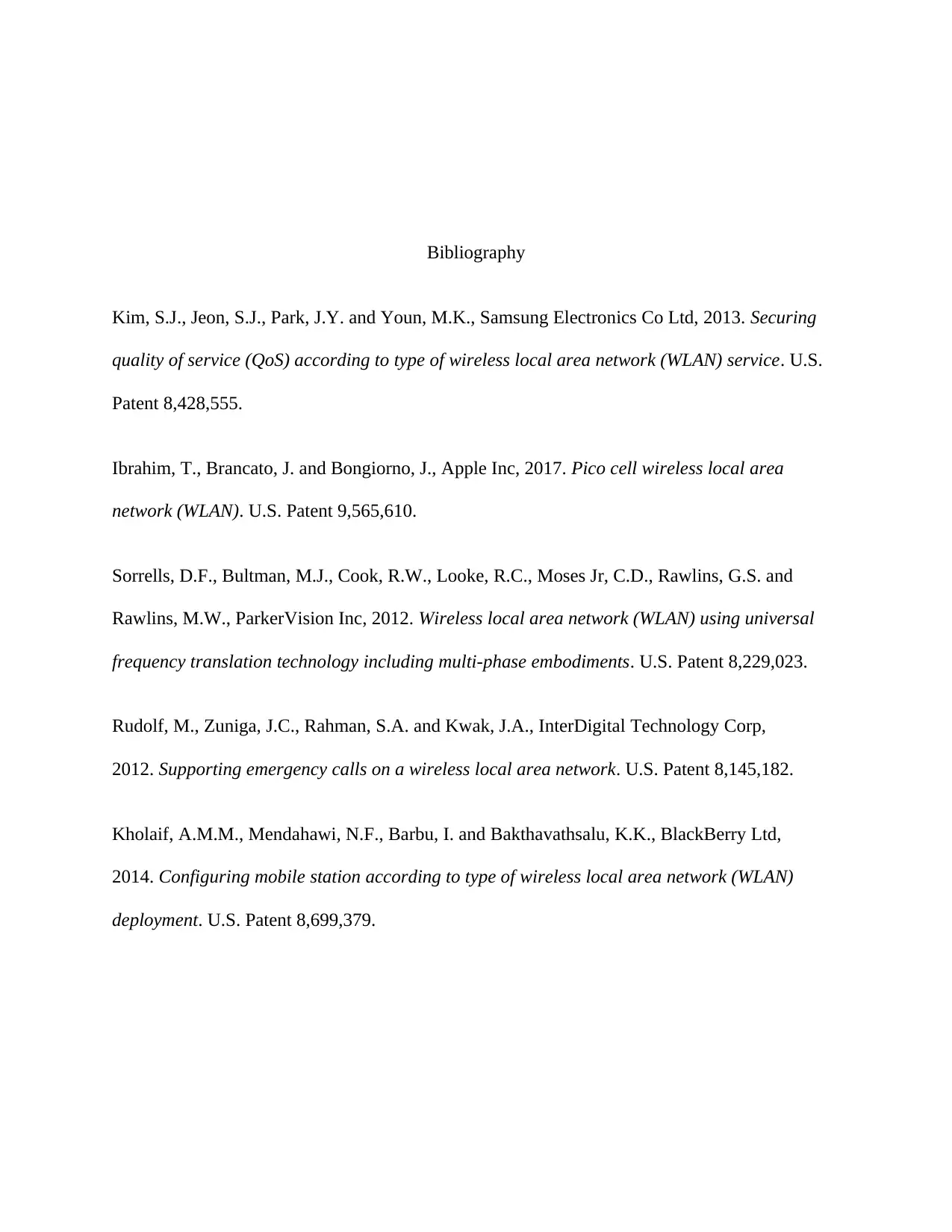
Bibliography
Kim, S.J., Jeon, S.J., Park, J.Y. and Youn, M.K., Samsung Electronics Co Ltd, 2013. Securing
quality of service (QoS) according to type of wireless local area network (WLAN) service. U.S.
Patent 8,428,555.
Ibrahim, T., Brancato, J. and Bongiorno, J., Apple Inc, 2017. Pico cell wireless local area
network (WLAN). U.S. Patent 9,565,610.
Sorrells, D.F., Bultman, M.J., Cook, R.W., Looke, R.C., Moses Jr, C.D., Rawlins, G.S. and
Rawlins, M.W., ParkerVision Inc, 2012. Wireless local area network (WLAN) using universal
frequency translation technology including multi-phase embodiments. U.S. Patent 8,229,023.
Rudolf, M., Zuniga, J.C., Rahman, S.A. and Kwak, J.A., InterDigital Technology Corp,
2012. Supporting emergency calls on a wireless local area network. U.S. Patent 8,145,182.
Kholaif, A.M.M., Mendahawi, N.F., Barbu, I. and Bakthavathsalu, K.K., BlackBerry Ltd,
2014. Configuring mobile station according to type of wireless local area network (WLAN)
deployment. U.S. Patent 8,699,379.
Kim, S.J., Jeon, S.J., Park, J.Y. and Youn, M.K., Samsung Electronics Co Ltd, 2013. Securing
quality of service (QoS) according to type of wireless local area network (WLAN) service. U.S.
Patent 8,428,555.
Ibrahim, T., Brancato, J. and Bongiorno, J., Apple Inc, 2017. Pico cell wireless local area
network (WLAN). U.S. Patent 9,565,610.
Sorrells, D.F., Bultman, M.J., Cook, R.W., Looke, R.C., Moses Jr, C.D., Rawlins, G.S. and
Rawlins, M.W., ParkerVision Inc, 2012. Wireless local area network (WLAN) using universal
frequency translation technology including multi-phase embodiments. U.S. Patent 8,229,023.
Rudolf, M., Zuniga, J.C., Rahman, S.A. and Kwak, J.A., InterDigital Technology Corp,
2012. Supporting emergency calls on a wireless local area network. U.S. Patent 8,145,182.
Kholaif, A.M.M., Mendahawi, N.F., Barbu, I. and Bakthavathsalu, K.K., BlackBerry Ltd,
2014. Configuring mobile station according to type of wireless local area network (WLAN)
deployment. U.S. Patent 8,699,379.
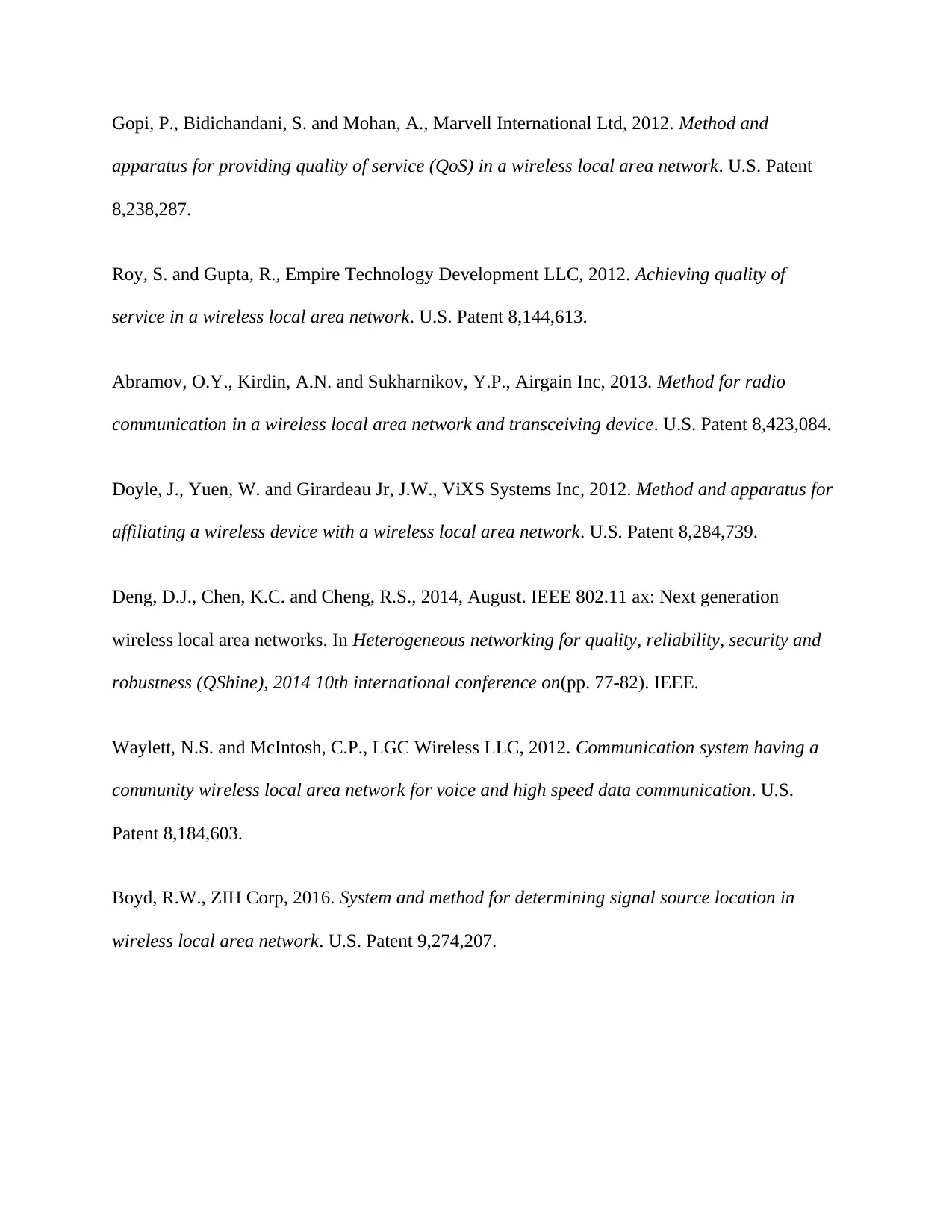
Gopi, P., Bidichandani, S. and Mohan, A., Marvell International Ltd, 2012. Method and
apparatus for providing quality of service (QoS) in a wireless local area network. U.S. Patent
8,238,287.
Roy, S. and Gupta, R., Empire Technology Development LLC, 2012. Achieving quality of
service in a wireless local area network. U.S. Patent 8,144,613.
Abramov, O.Y., Kirdin, A.N. and Sukharnikov, Y.P., Airgain Inc, 2013. Method for radio
communication in a wireless local area network and transceiving device. U.S. Patent 8,423,084.
Doyle, J., Yuen, W. and Girardeau Jr, J.W., ViXS Systems Inc, 2012. Method and apparatus for
affiliating a wireless device with a wireless local area network. U.S. Patent 8,284,739.
Deng, D.J., Chen, K.C. and Cheng, R.S., 2014, August. IEEE 802.11 ax: Next generation
wireless local area networks. In Heterogeneous networking for quality, reliability, security and
robustness (QShine), 2014 10th international conference on(pp. 77-82). IEEE.
Waylett, N.S. and McIntosh, C.P., LGC Wireless LLC, 2012. Communication system having a
community wireless local area network for voice and high speed data communication. U.S.
Patent 8,184,603.
Boyd, R.W., ZIH Corp, 2016. System and method for determining signal source location in
wireless local area network. U.S. Patent 9,274,207.
apparatus for providing quality of service (QoS) in a wireless local area network. U.S. Patent
8,238,287.
Roy, S. and Gupta, R., Empire Technology Development LLC, 2012. Achieving quality of
service in a wireless local area network. U.S. Patent 8,144,613.
Abramov, O.Y., Kirdin, A.N. and Sukharnikov, Y.P., Airgain Inc, 2013. Method for radio
communication in a wireless local area network and transceiving device. U.S. Patent 8,423,084.
Doyle, J., Yuen, W. and Girardeau Jr, J.W., ViXS Systems Inc, 2012. Method and apparatus for
affiliating a wireless device with a wireless local area network. U.S. Patent 8,284,739.
Deng, D.J., Chen, K.C. and Cheng, R.S., 2014, August. IEEE 802.11 ax: Next generation
wireless local area networks. In Heterogeneous networking for quality, reliability, security and
robustness (QShine), 2014 10th international conference on(pp. 77-82). IEEE.
Waylett, N.S. and McIntosh, C.P., LGC Wireless LLC, 2012. Communication system having a
community wireless local area network for voice and high speed data communication. U.S.
Patent 8,184,603.
Boyd, R.W., ZIH Corp, 2016. System and method for determining signal source location in
wireless local area network. U.S. Patent 9,274,207.
Paraphrase This Document
Need a fresh take? Get an instant paraphrase of this document with our AI Paraphraser
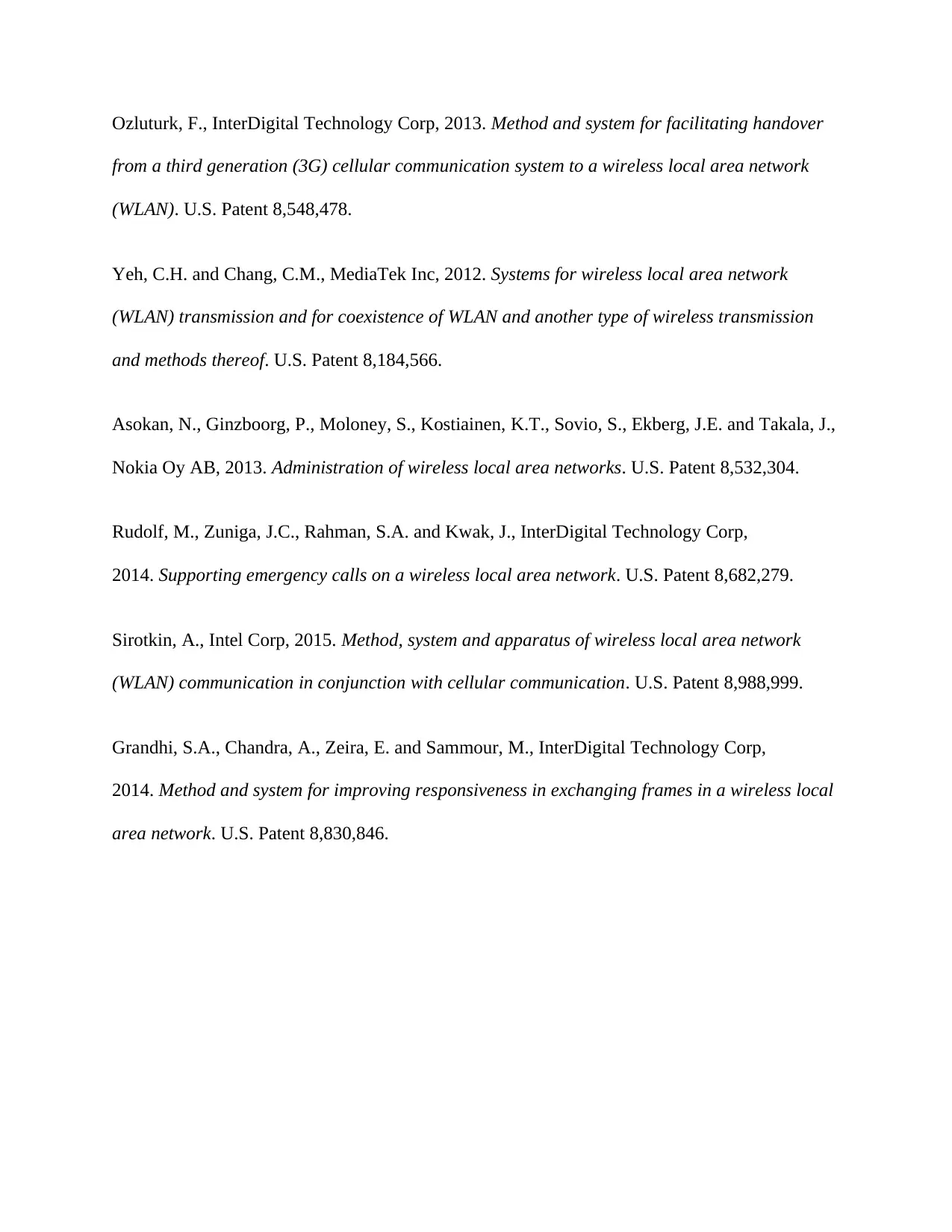
Ozluturk, F., InterDigital Technology Corp, 2013. Method and system for facilitating handover
from a third generation (3G) cellular communication system to a wireless local area network
(WLAN). U.S. Patent 8,548,478.
Yeh, C.H. and Chang, C.M., MediaTek Inc, 2012. Systems for wireless local area network
(WLAN) transmission and for coexistence of WLAN and another type of wireless transmission
and methods thereof. U.S. Patent 8,184,566.
Asokan, N., Ginzboorg, P., Moloney, S., Kostiainen, K.T., Sovio, S., Ekberg, J.E. and Takala, J.,
Nokia Oy AB, 2013. Administration of wireless local area networks. U.S. Patent 8,532,304.
Rudolf, M., Zuniga, J.C., Rahman, S.A. and Kwak, J., InterDigital Technology Corp,
2014. Supporting emergency calls on a wireless local area network. U.S. Patent 8,682,279.
Sirotkin, A., Intel Corp, 2015. Method, system and apparatus of wireless local area network
(WLAN) communication in conjunction with cellular communication. U.S. Patent 8,988,999.
Grandhi, S.A., Chandra, A., Zeira, E. and Sammour, M., InterDigital Technology Corp,
2014. Method and system for improving responsiveness in exchanging frames in a wireless local
area network. U.S. Patent 8,830,846.
from a third generation (3G) cellular communication system to a wireless local area network
(WLAN). U.S. Patent 8,548,478.
Yeh, C.H. and Chang, C.M., MediaTek Inc, 2012. Systems for wireless local area network
(WLAN) transmission and for coexistence of WLAN and another type of wireless transmission
and methods thereof. U.S. Patent 8,184,566.
Asokan, N., Ginzboorg, P., Moloney, S., Kostiainen, K.T., Sovio, S., Ekberg, J.E. and Takala, J.,
Nokia Oy AB, 2013. Administration of wireless local area networks. U.S. Patent 8,532,304.
Rudolf, M., Zuniga, J.C., Rahman, S.A. and Kwak, J., InterDigital Technology Corp,
2014. Supporting emergency calls on a wireless local area network. U.S. Patent 8,682,279.
Sirotkin, A., Intel Corp, 2015. Method, system and apparatus of wireless local area network
(WLAN) communication in conjunction with cellular communication. U.S. Patent 8,988,999.
Grandhi, S.A., Chandra, A., Zeira, E. and Sammour, M., InterDigital Technology Corp,
2014. Method and system for improving responsiveness in exchanging frames in a wireless local
area network. U.S. Patent 8,830,846.
1 out of 38
Your All-in-One AI-Powered Toolkit for Academic Success.
+13062052269
info@desklib.com
Available 24*7 on WhatsApp / Email
![[object Object]](/_next/static/media/star-bottom.7253800d.svg)
Unlock your academic potential
© 2024 | Zucol Services PVT LTD | All rights reserved.